Project Tag: Landscape
Mission Garden Unit
A Secret Garden
This once commercial unit in the heart of the Mission District of San Francisco was converted into a uniquely grounded single-family home. Historically, this century old 2-story wood frame building built in the 1890’s was part of a dispersed 26th Street merchant corridor, which over time has gradually migrated to nearby Mission and Valencia Streets, as housing pressures in the city have steadily increased. The shop front has been updated to a compressed front yard, while the rear “yard” is transformed into a completive garden – enclosed as is a typical condition in the dense Mission District, transformed here into a quiet, private and nature-animated oasis which the new home relies on for air, light, color and texture.
Space dissolves into a bamboo grove
This new ground floor unit connects the busy street front through an ordered façade of 100% reclaimed glass arranged like scales in a steel matrix, to the quite rear grove of timber bamboo, ferns and Japanese maple. The architectural space moves through an open glass wall into dappled shade and the sound of wind rustles the 40ft lush canopy. A customized fence unifies the edges with a color palette derived from the life cycle of the timber bamboo trunks.
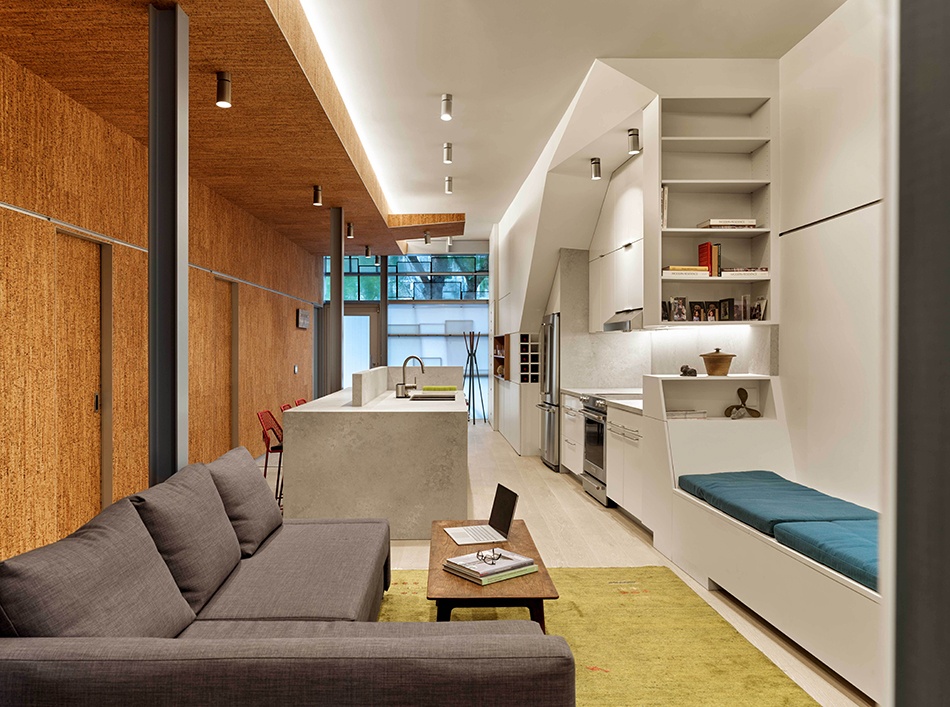
A river of cork runs through it
The interior plan is inverted – to provide bedroom and a private office off the garden while the core of the home is an open plan of living and dining around an open kitchen. The living space is organized by a continuous long and high surface of cork meant to create a soft acoustic environment and flexible display throughout the home, while also concealing the volumes for mechanical, storage and bathrooms. The floor to ceiling expanses of cork surface eventually envelope an entire sensual enclosure at the master bedroom, where the cork surround one on walls, doors and ceilings.
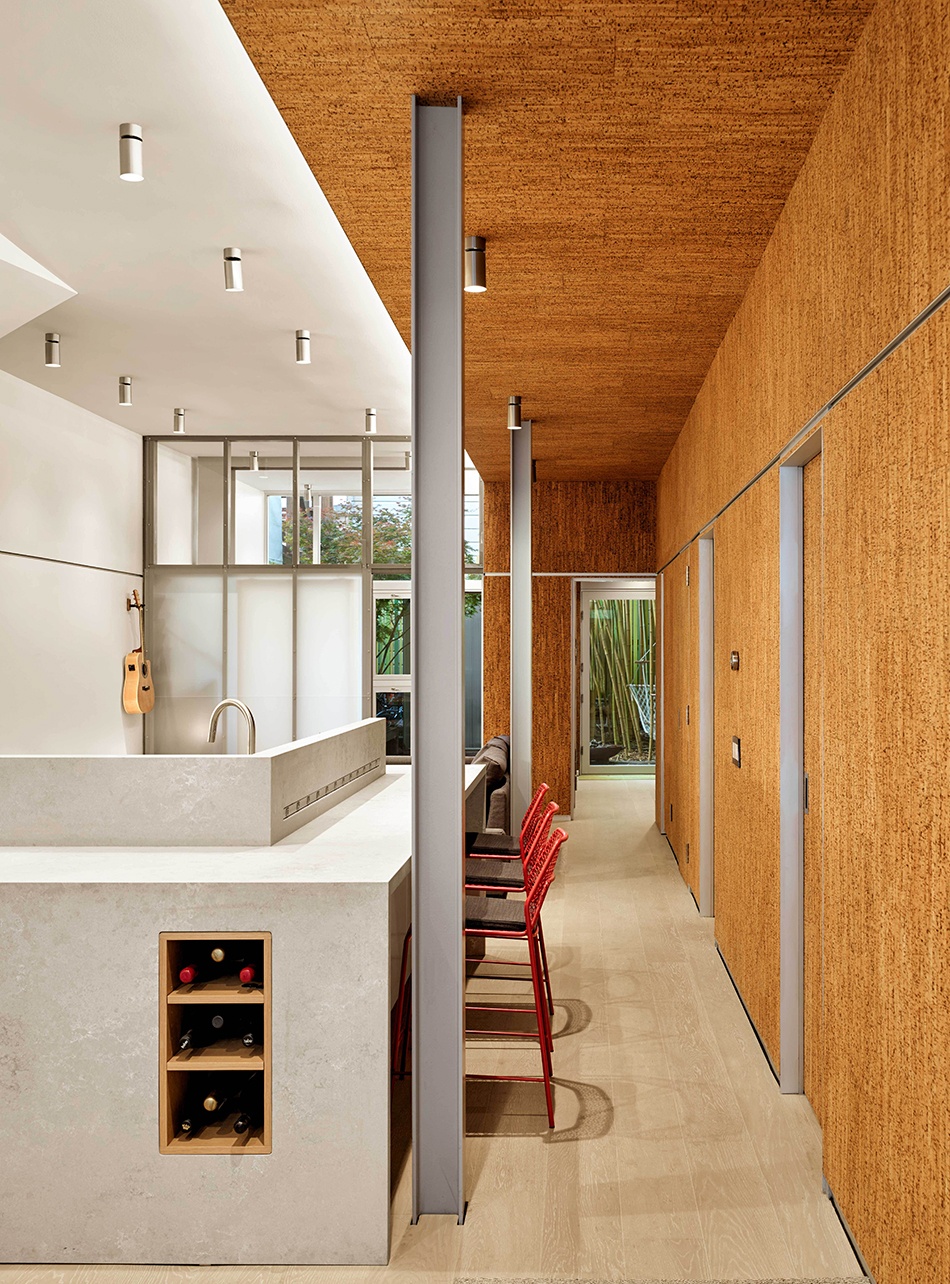
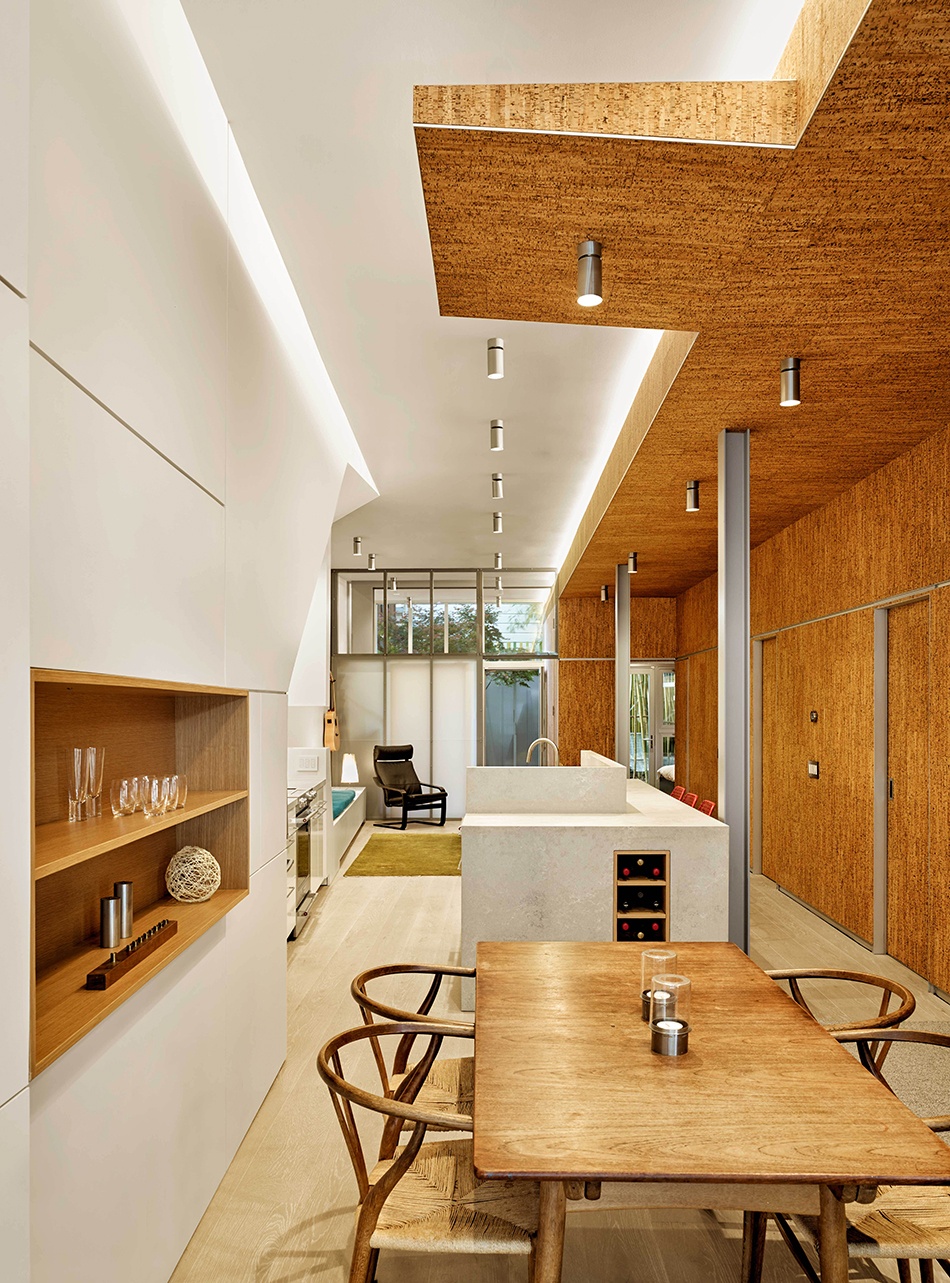
Space and Light in balance with Nature
The interior space maximizes the limited 1,200 sf. floor plan by way of integrating storage within the sculpted cabinets and built-in seating volumes. The storage perforates and frames the unencumbered space, along with the use of glass walls and sliding partitions to allow for functionally distinct areas to work in concert with one another – providing openness, privacy and separation as needed, and allowing natural light to reach deep into the narrow home.
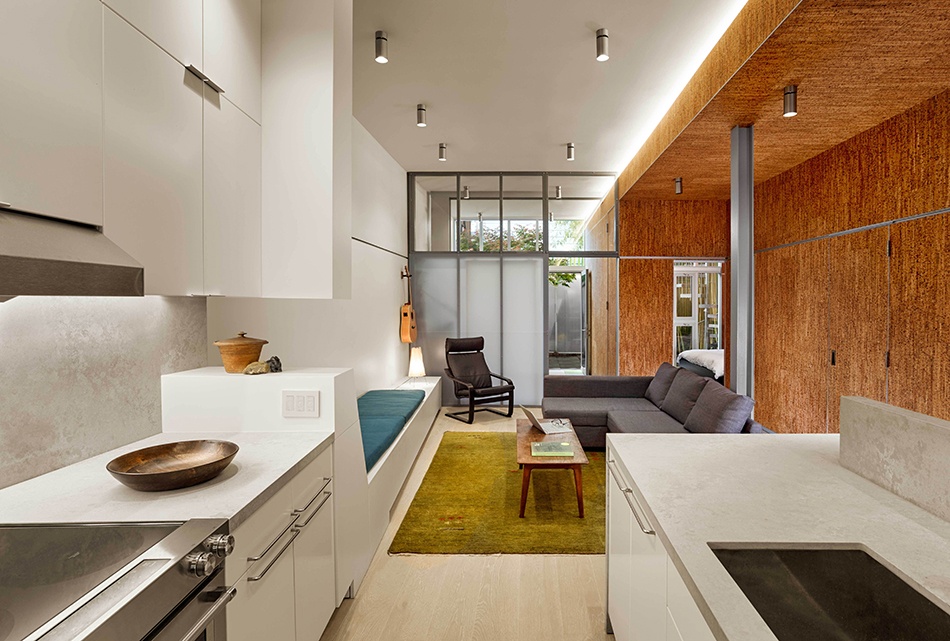
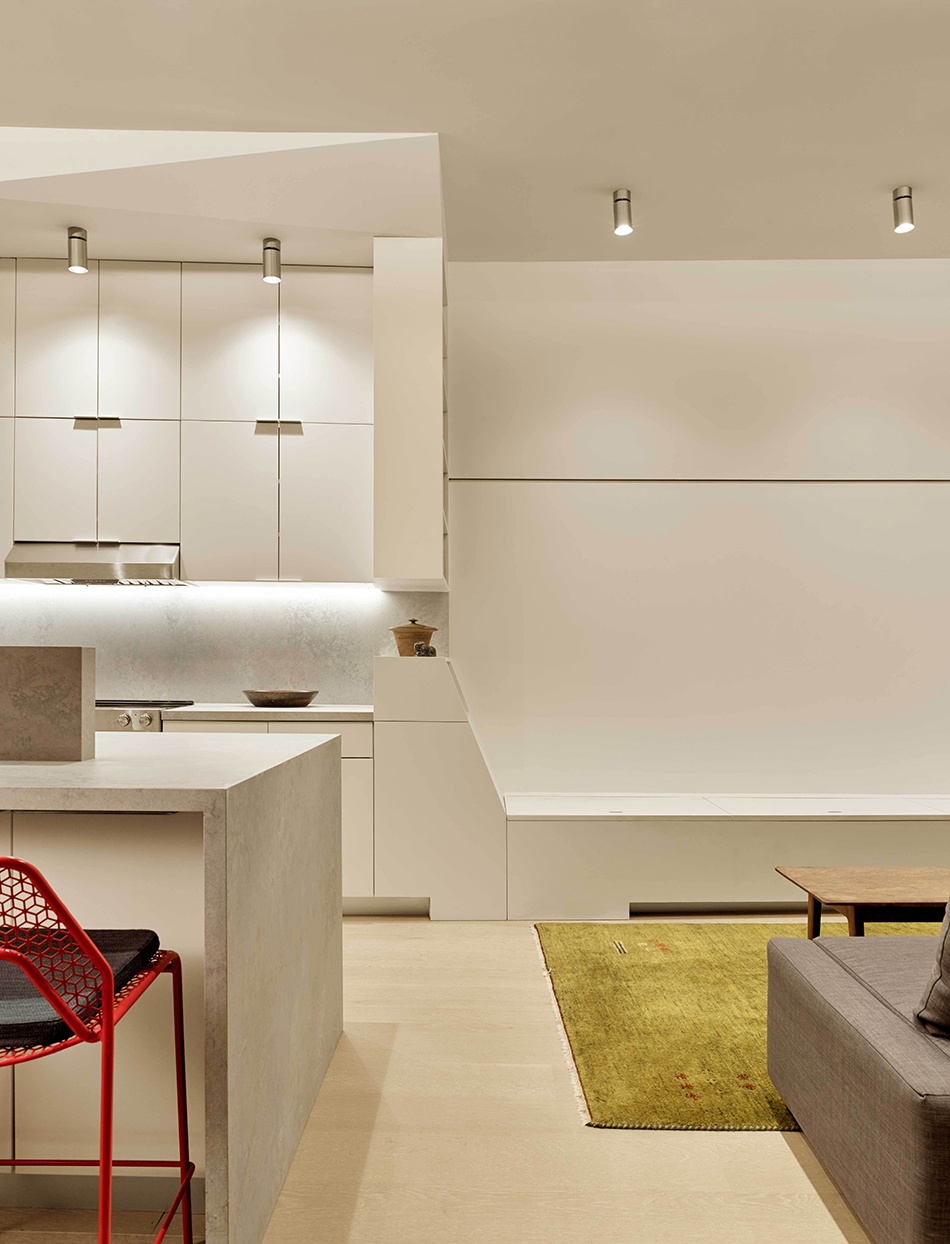
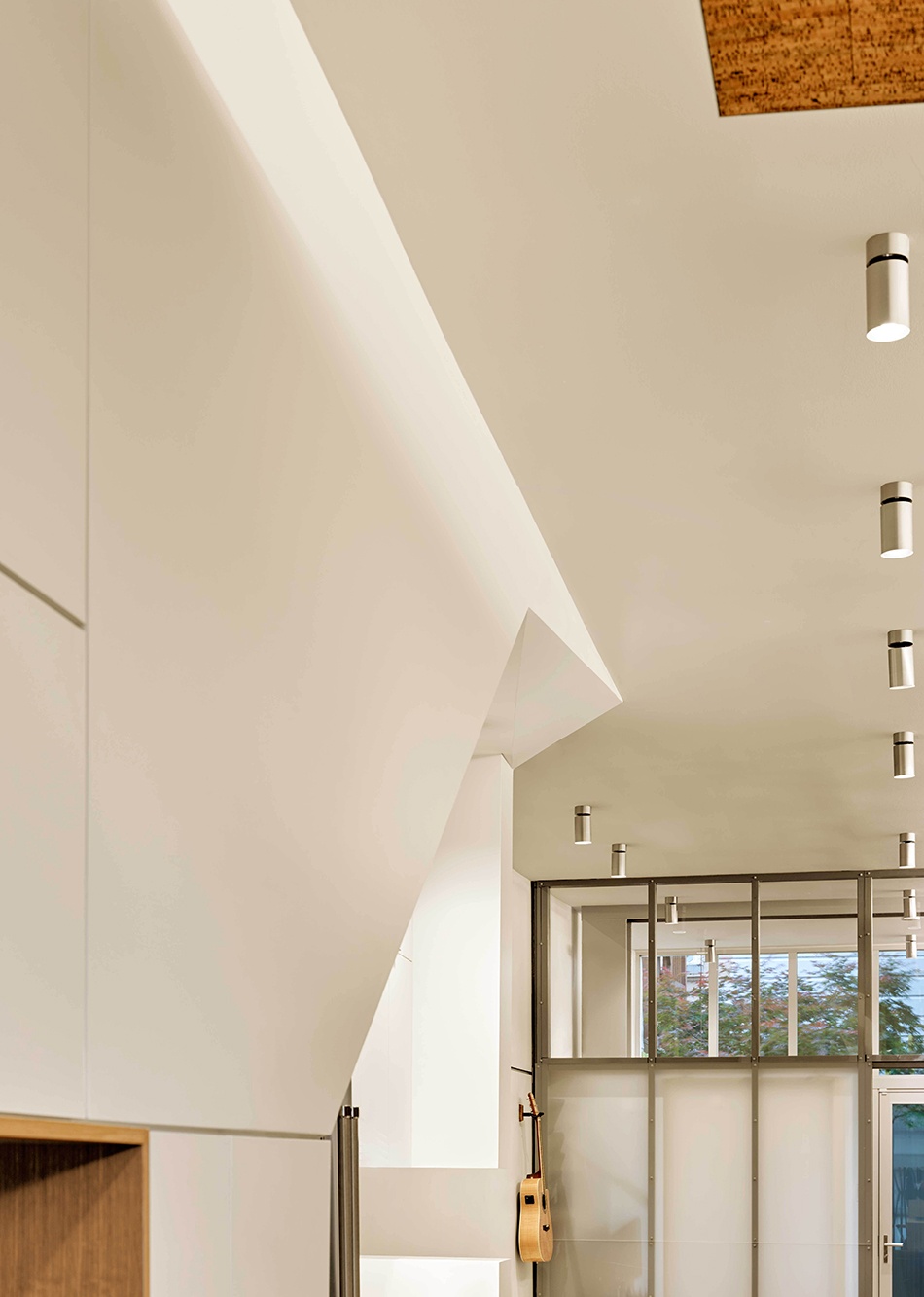
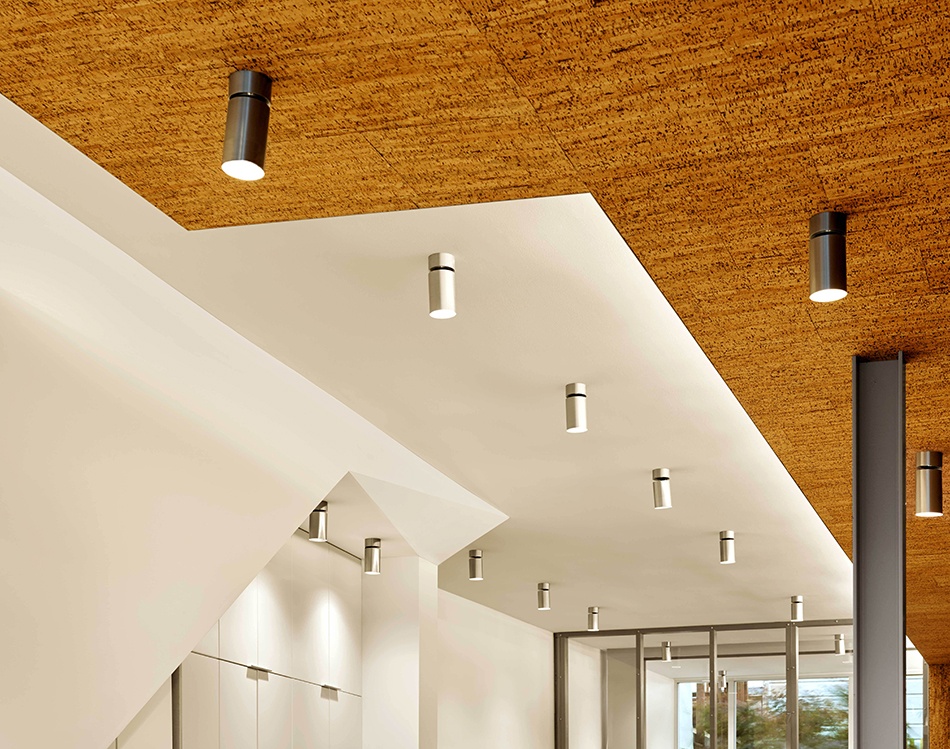
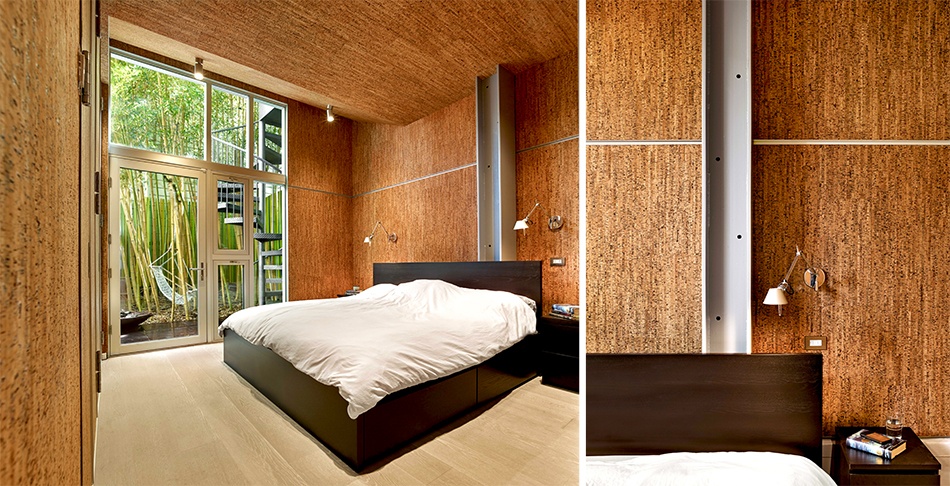
Location: San Francisco, California
Owner/Client: Undisclosed
Scope: Interior Renovation / Garden Space
Status: Completed 2020
Photography: Cesar Rubio
Myrtle Street BARK!let
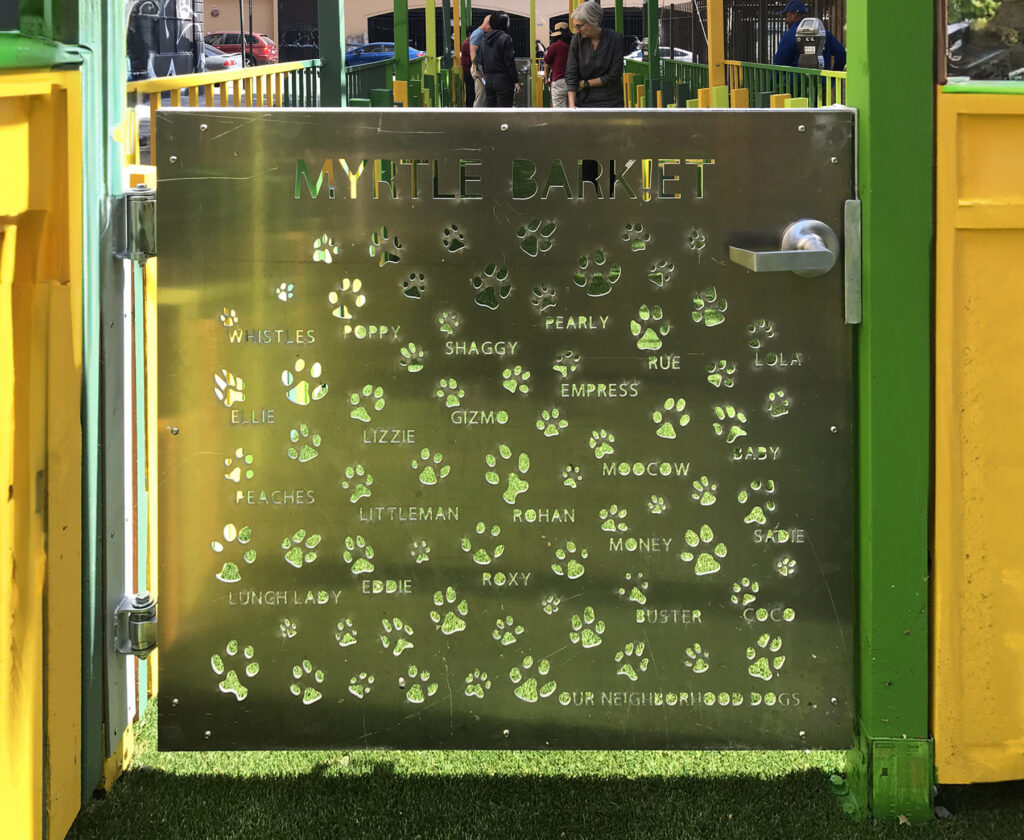
For the Dogs
Myrtle Street’s new BARK!let transforms three public, on-street parking spaces into a 60-foot dog run at the heart of the San Francisco’s Tenderloin District. The Lower Polk Alleyways District Community Benefit District, and the Tenderloin Community came to INTERSTICE Architects in order to collaborate on the design of a new Parklet form: specifically, one for dogs to enjoy. And so the idea for a BARK!let was born.
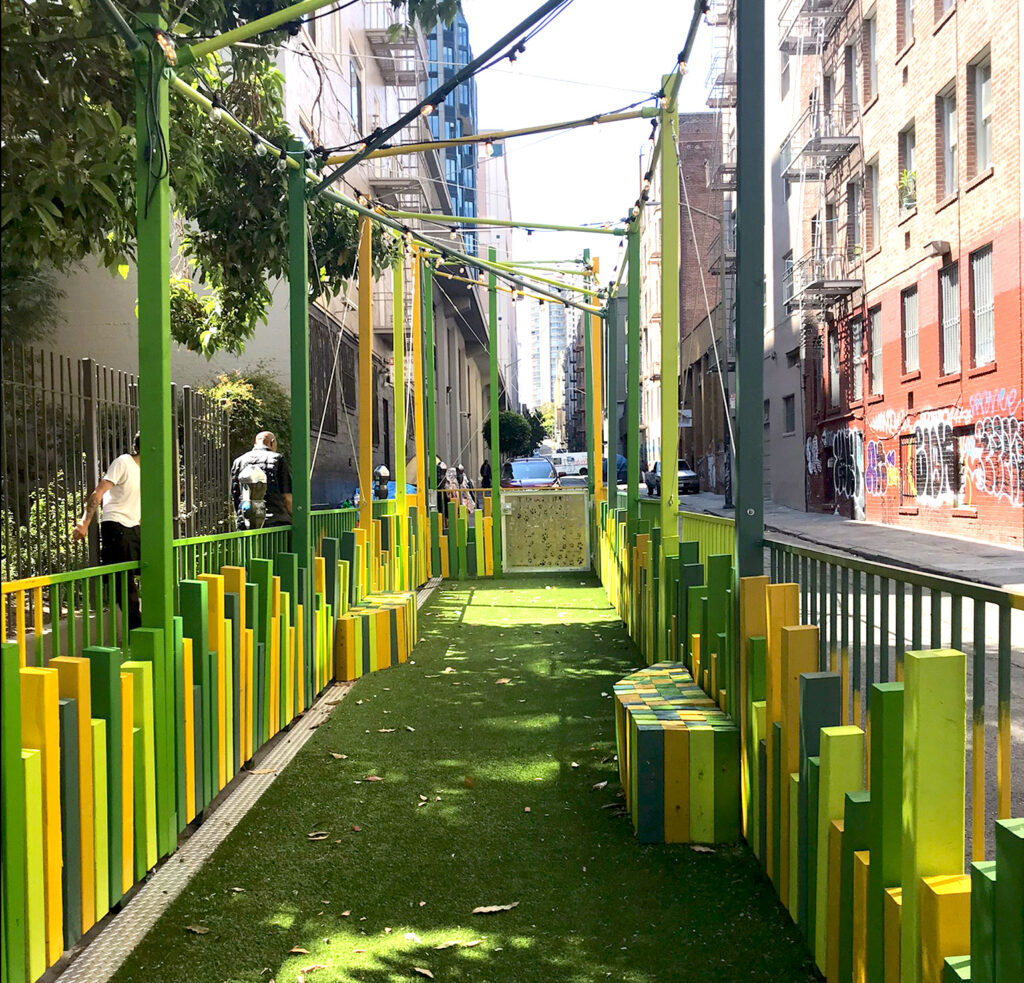
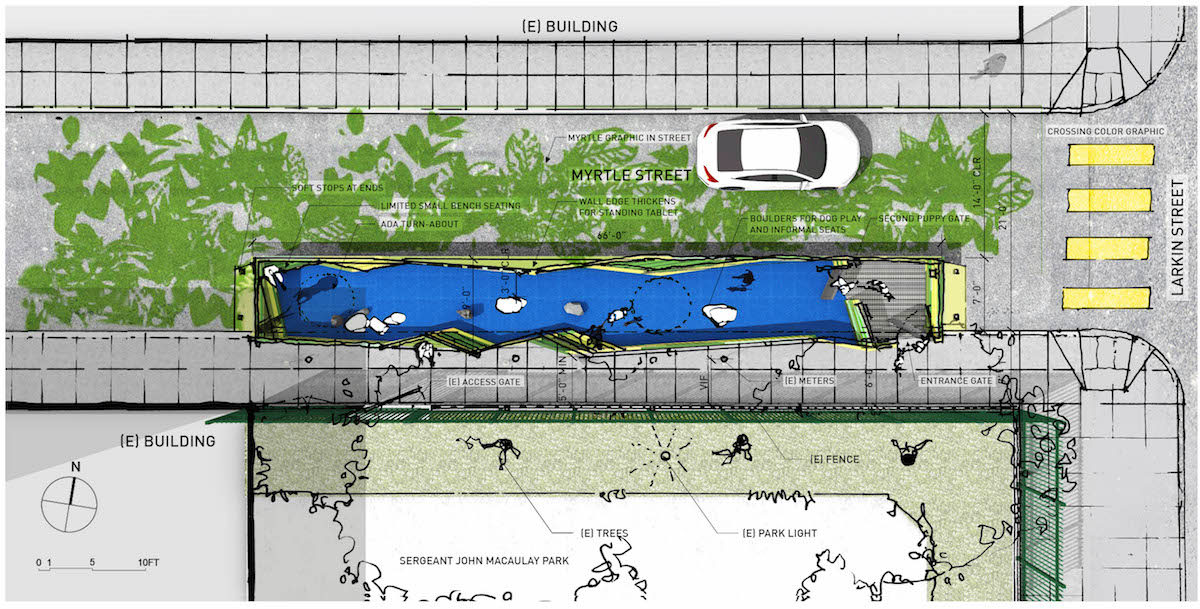
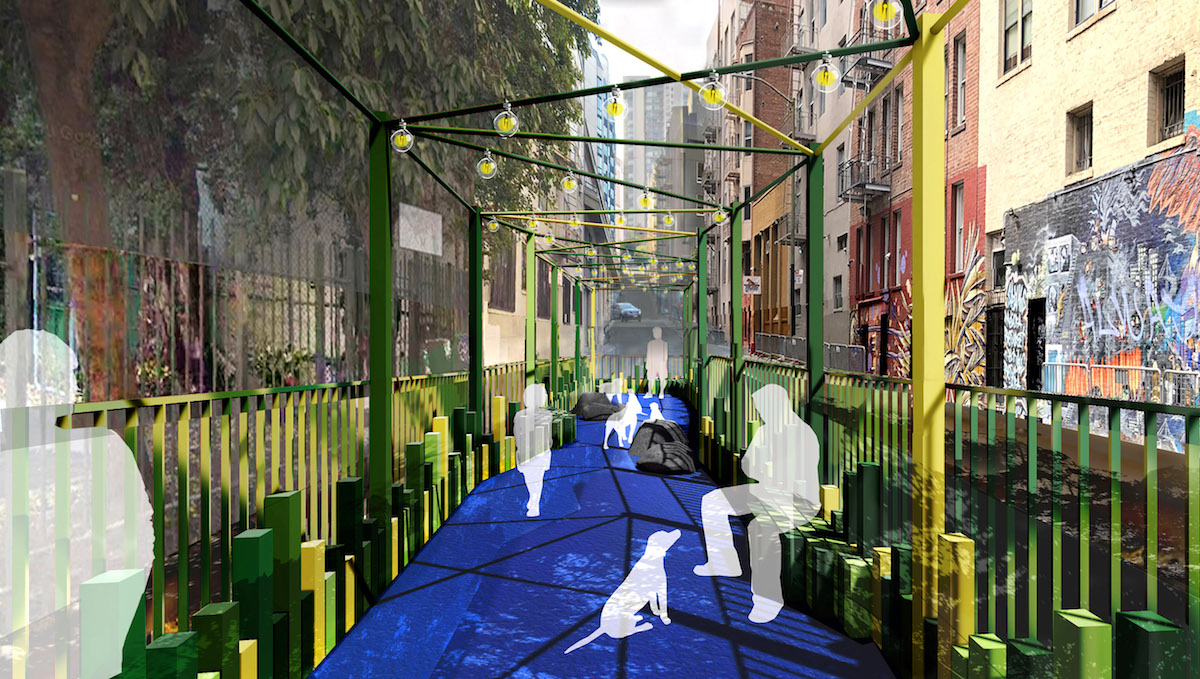
Create New Spaces
In recognition that there was really no place to allow pets off-leash to play in the surrounding neighborhood, the Lower Polk CBD applied for a grant to design and permit a new BARK!let. The site beside McCauley Park was chosen for its location adjacent to the recently renovated children’s playground. In alignment with the Lower Polk Alleyways District Vision Plan in which Myrtle Alley aspires to be the “Park Alley,” the BARK!let focuses on the open space, and existing courtyards and park amenities.
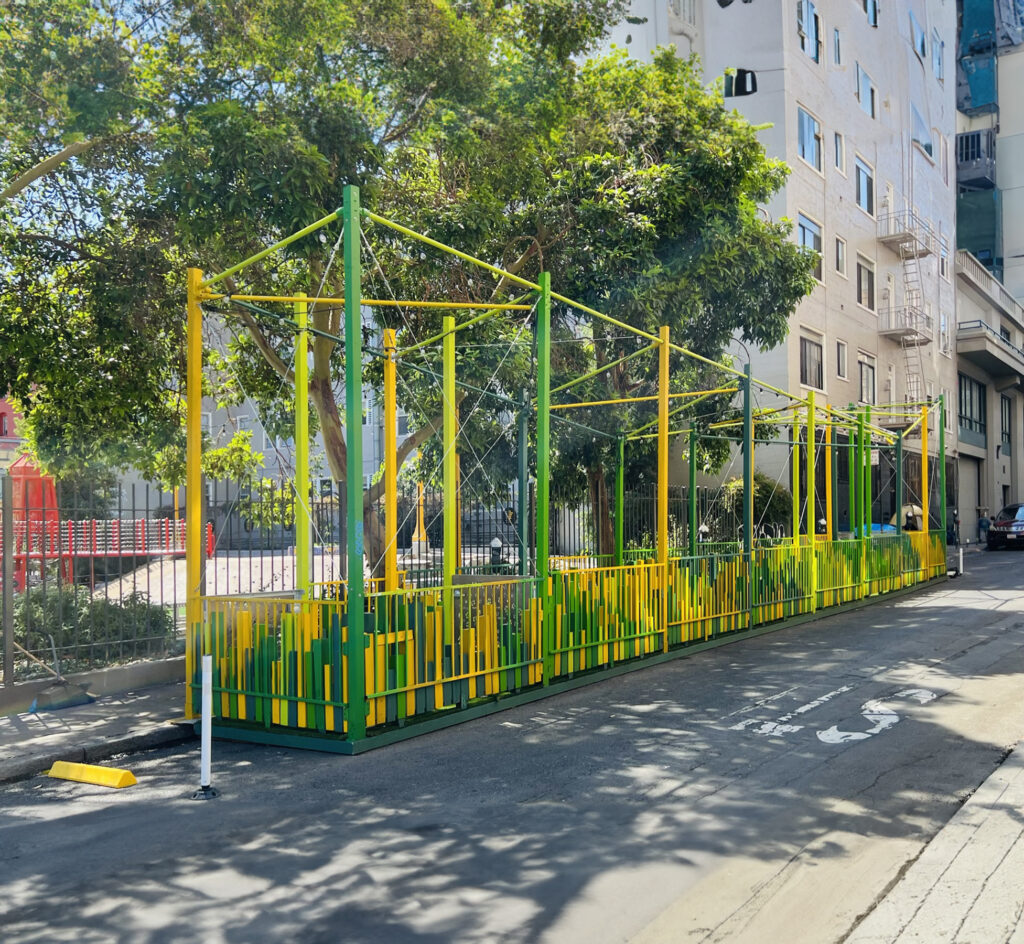
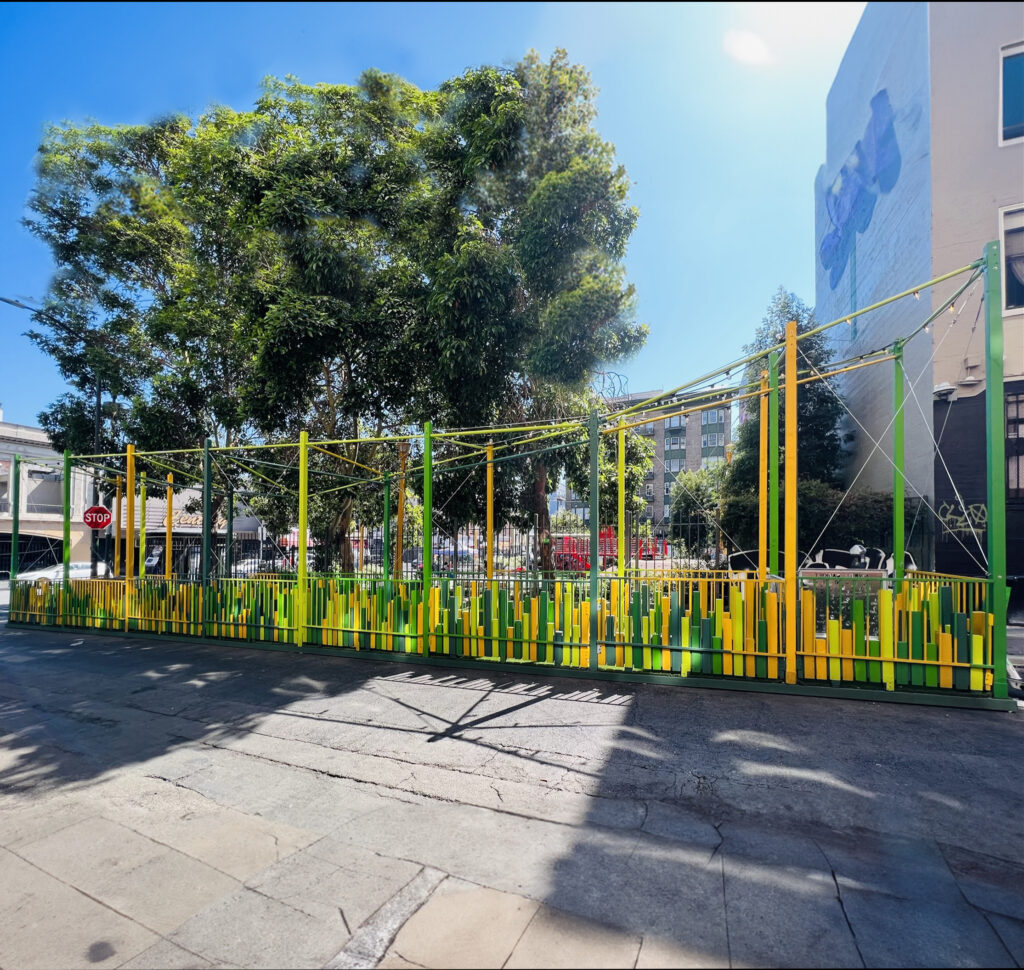
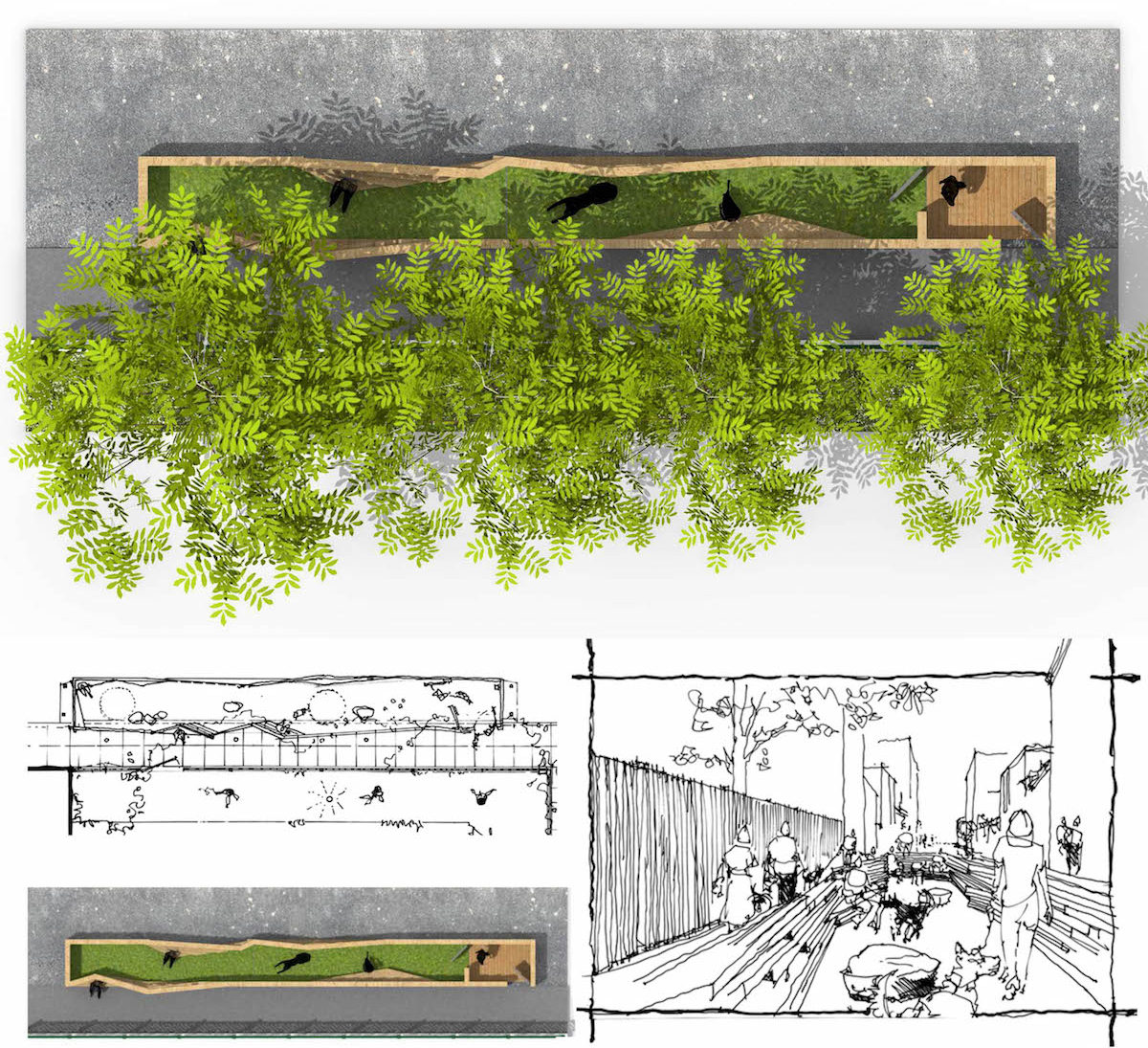
Reclaiming the Streets
The Myrtle Street BARK!let will reclaim three on-street parking spaces in an effort to provide a shared space for the growing number of pet owners in this rapidly expanding residential mixed-use area. Why have our shared streets rented by the city for private vehicle parking, when we can all benefit from this same public space to enjoy as a linear park? The BARK!let creates space not only for pet relief, but also a place in the public commons where pet owners can gather safely to let their dogs enjoy each other’s company. The community was intimately involved in the design development. Over multiple presentations allowing input from stakeholders and pet owners, the design evolved towards more transparency, providing light for night-time use, and establishing regulations to help ensure safety and greater containment.
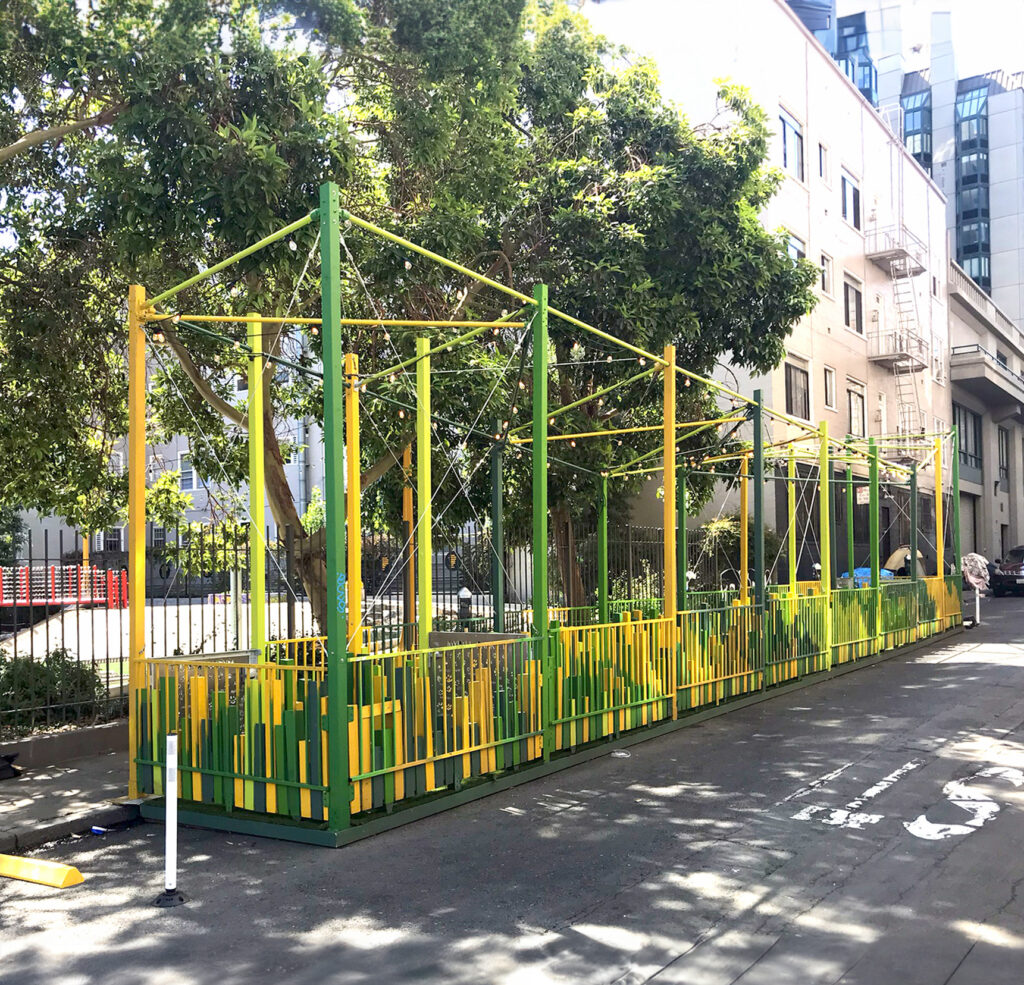

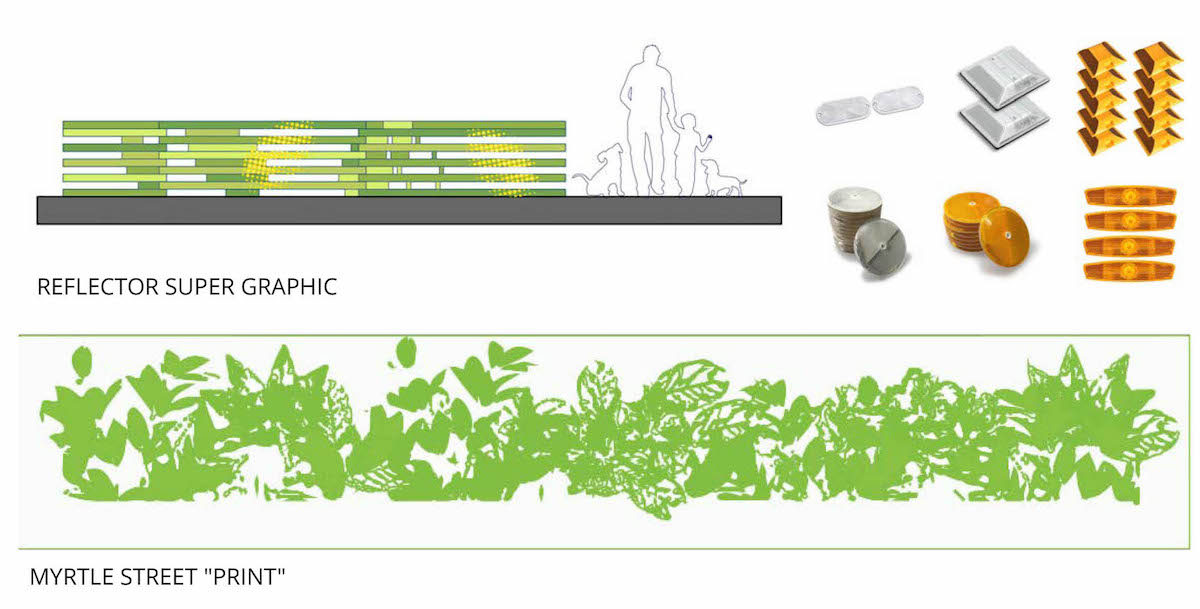
Designed for Play
The BARK!let is six-by-nine-feet wide, and over 60 feet long with double gates at both ends made with a colorful graphic language of simple off-the-shelf component parts that are easily maintained. INTERSTICE added an anti-graffiti pattern derived from the myrtle tree’s leaves and flowers in honor of the street’s namesake. With lights, turf to match the blue park next door, and boulders, the park provides an exciting and playful environment for the community’s pups, both day and night.
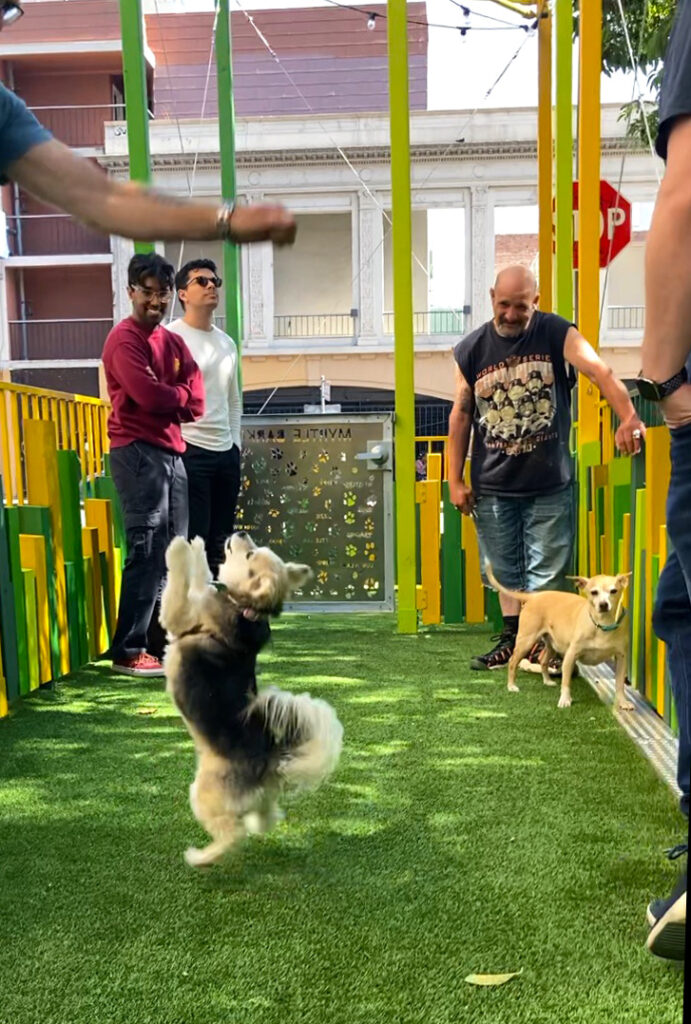
Screenshot
Location: Corner of Larkin Street & Myrtle Street, San Francisco
Owner/Client: Lower Polk CBD
Scope: Parklet for dogs
Status: In Progress
Photography: N/A
Polk Plaza
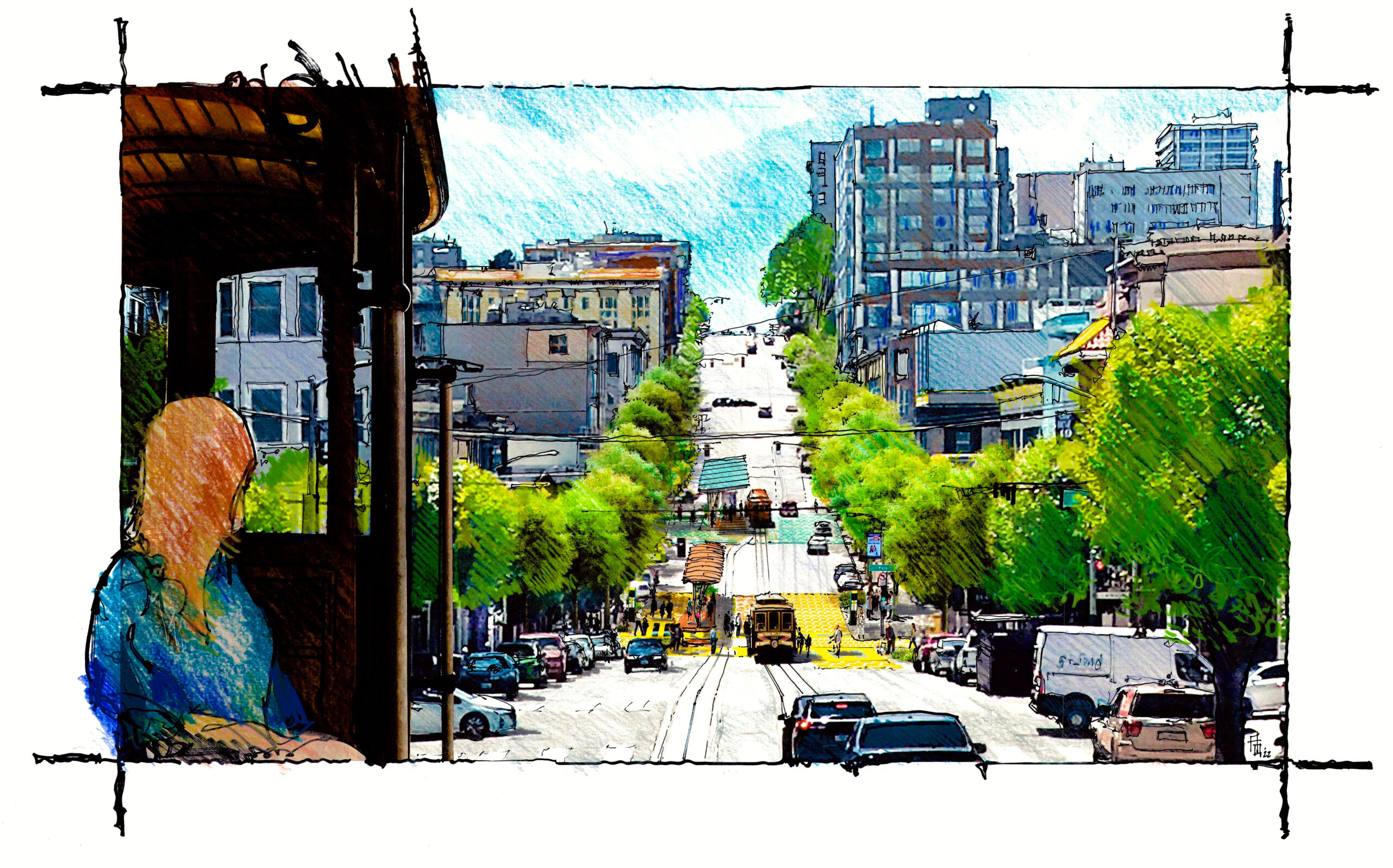
Grass Roots Urbanism
The culmination of many community-focused design workshops, and stakeholder input, that created the California Cable Car Turn-Around Vision Plan ignited the formation of a separate group committed to seeing this area become the gateway to the Polk Street mercantile corridor. The idea of creating a more formalized pedestrian focused transit node, away from the busy Van Nes corridor, here at the Polk intersection was the starting point for the Polk Plaza Vision

A New Cable Car Social Hub
Working with the growing group of “friends” of Polk-Plaza, INTERSTICE was asked to create an addendum to the original vision plan that focused on the Polk intersection cable car stop, with its obvious connections to the community, and to the heritage of San Francisco’s iconic cable car past. The intersection is envisioned to serve as the gateway to the city’s western center – With widened sidewalks, bulbed curbs, street amenities and plantings at the four corners, the intersection at California street forms a larger hub connecting the bike lanes, and personal mobility routes to this very walkable neighborhood, with its heritage merchants, eateries and lively bars, that characterize this thriving Polk Gulch neighborhood.
From this new activated area, visitors and locals are just steps away from Nob Hill, Russian Hill, Cathedral Hill, Civic Center and the Tenderloin neighborhoods – so, it seemed the natural place to envision a lively orientation point at the western most terminus of the Cable car system.
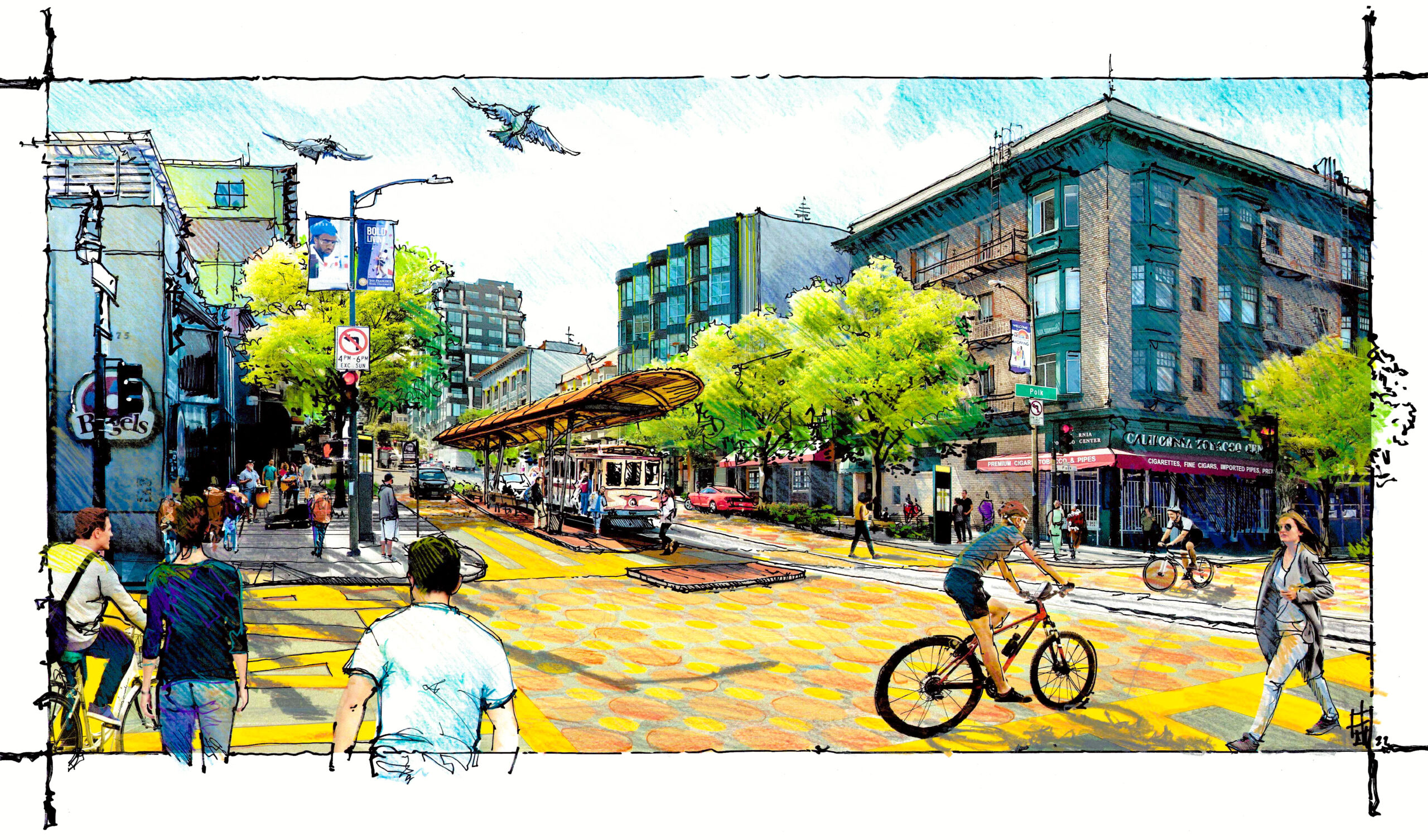
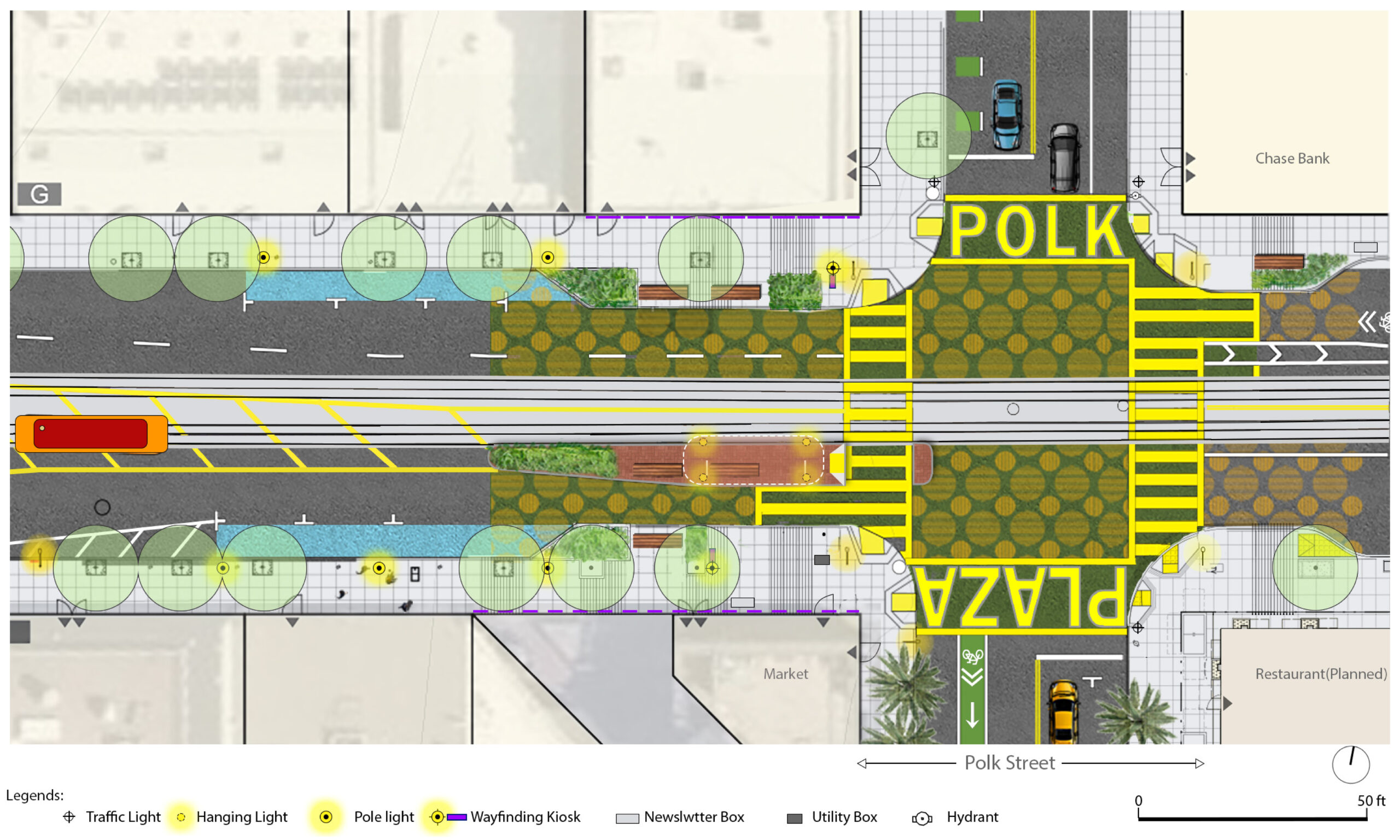
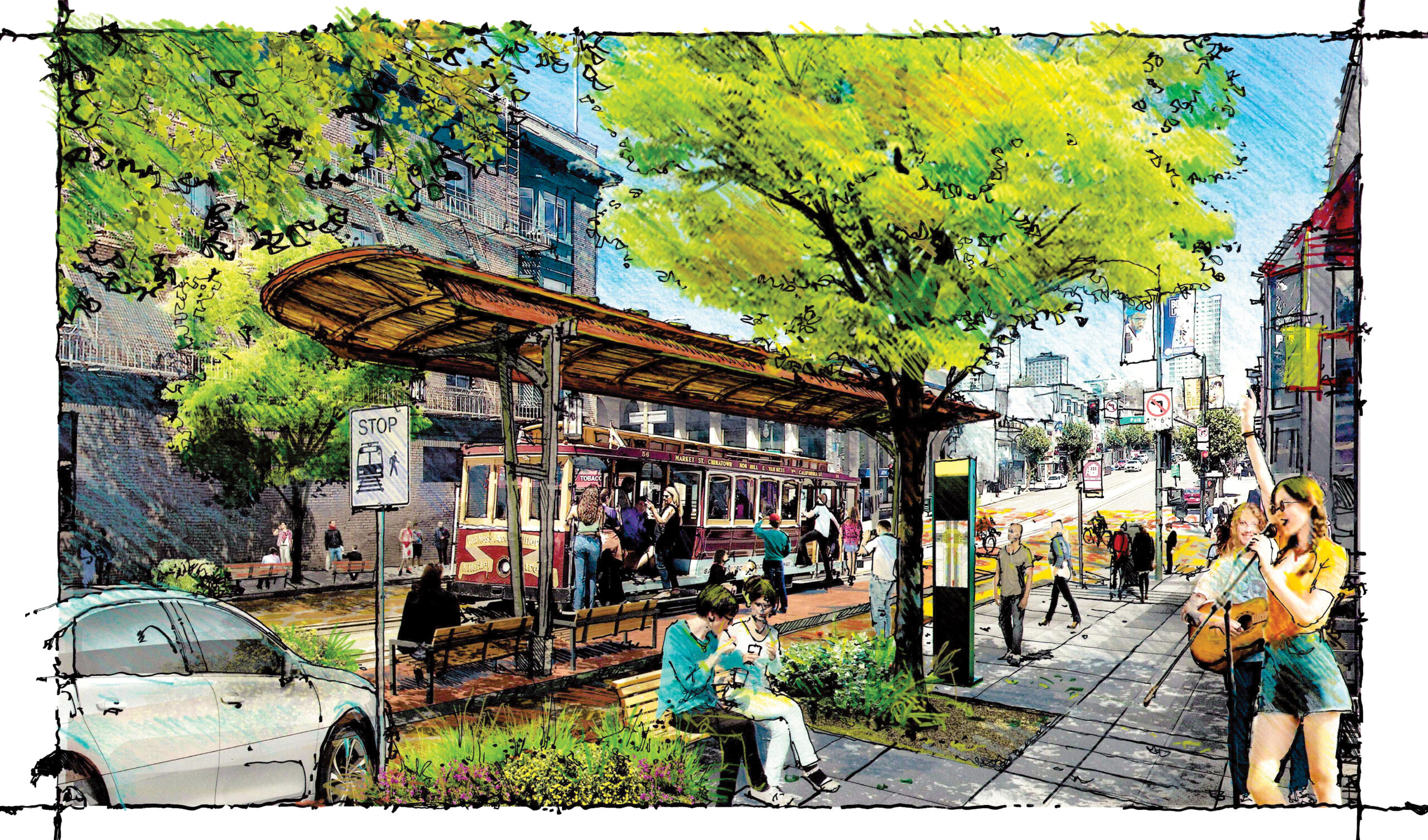
Focusing Community
Here Street musicians would serenade the waiting commuters, the passing shoppers, and the tourists on their elevated journey over the hills – to and from the Embarcadero and Chinatown. The plan imagines a redesigned civic space that makes people welcome and provides opportunity for interpretive signage, wayfinding , and musical programming from the nearby Music City Studios and hotel. The entire Vision plan can be found here – with the Polk Plaza addendum published here as a standalone document.
Join the friends of Polk Plaza and the Polk Corridor Neighbors as we continue to work on the best public commons for our San Francisco neighborhood.
Location: California and Polk Streets, San Francisco.
Client: Lower Polk CBD and Friends of Polk Plaza
Scope: Urban Design
Status: Vision Plan
Vallejo Street Residence
Expanding Into the Outdoors
A home in the Pacific Heights neighborhood of San Francisco expands to create a garden connector, allowing a realigned kitchen to become the conduit between the original formal dining room and a new informal family room that opens out onto a transformed garden—extending the home outdoors.
Home and Garden
This elegant, historic Dutch-style home in San Francisco was in need of a better connection to its garden, an under-used and difficult-to-negotiate rear yard. INTERSTICE Architects knew the solution was both architectural and landscape-focused. It was a question of reconfiguration of both the kitchen and its awkward relationship to the steeply sloped site, which had limited the gardens usability for decades. The home was expanded and dug out to create new space at the lower level, while allowing the yard to establish a continuous relationship to the main living floor. The interiors were realigned to establish the kitchen as a connecting social space between the new informal, private family room, while the exterior garden was remade to be a clearly articulated extension of the social and entertainment level of the home.
Shaping the “Smart-Wall”
A full height cabinet “smart-wall” inside the residence epitomizes the key aspect of this project: the integration of spaces. This smart-wall establishes a material transition between the kitchen—where it acts as a storage and shelving wall—into the family room. From this living space, the design transforms, containing a new hearth, skylight, and entertainment center, before moving all the way through to the garden patio window wall—where it thickens to conceal a secret, private full bathroom.
Framed by Wood
Outside, the landscape is restructured from three unusable levels into a spacious two-level terraced garden. The living level provides a patio deck beyond the dynamic glass wall of the family room for exterior dining. An in-wall fountain anchors one end, along with a wood clad raised sun garden and a cozy fireplace, all framed by the warmth of wood and dark, smooth concrete. Together these materials form a seat back that wraps the retaining walls and connects the more remote and private upper garden level. The upper garden is set on a wood clad deck with a sunken hot tub, an outdoor shower, and a hammock, all sheltered by deep plantings and mature tree ferns.
Natural as the Counterpoint
The predominance of natural exposed materials permeates the garden and the interior palette, allowing for a more sensual counterpoint from the rest of the formal and more traditional home. Warm materials and discreet lighting create an inviting and pleasant night presence, while communicating an easy comfort as the home dissolves from interior to outdoors across the expansive glass facade. Festoon lights above and a spiral stair to the upstairs extended green garden roof improve the second level private studio.
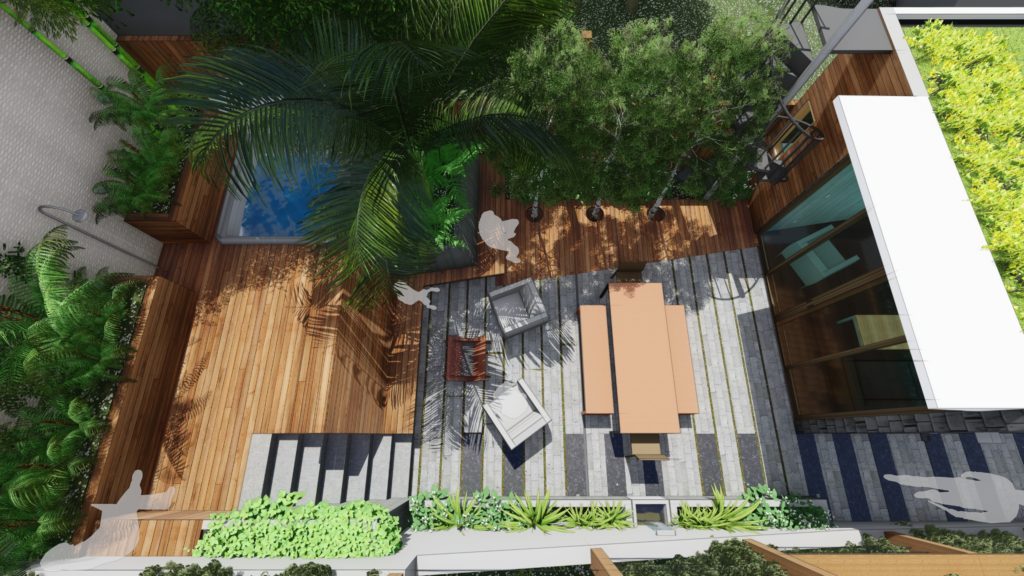
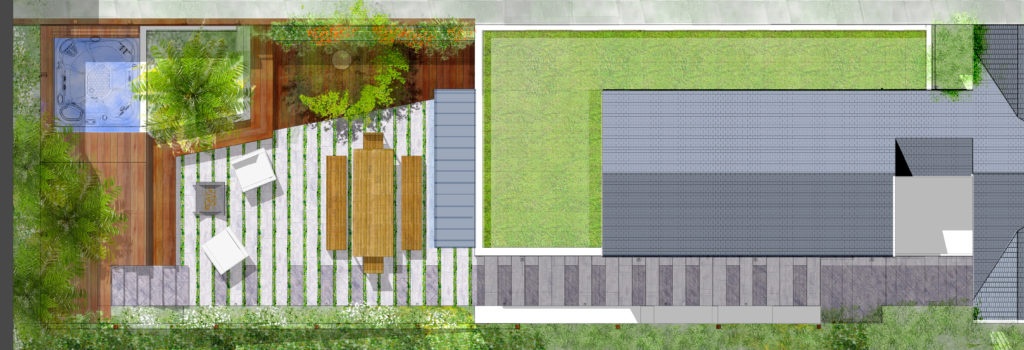
Bringing Light Down
INTERSTICE designed the kitchen and light-well as a light-emitting garden column planted with tree bamboo. This space was particularly meant to bring light down into the new, lower media and guest room, excavated to host service spaces including an independent laundry room and full bath that allows for connection or full separation from the home office level below, and for the owners to enjoy increased privacy.
Location: Vallejo Street, Pacific Heights, San Francisco.
Owner/Client: Undisclosed
Scope: Residential Renovation & Garden Design
Status: Completed 2020
Photography: Cesar Rubio
MIRA SF – TRANSBAY BLOCK 1
This unique development is a key urban ecological linkage in the transformation of the Transbay neighborhood from transit infrastructure to community. Centering on the word ‘ecology’ and its original Greek sense of “house” or “environment”, the project encourages interactions, engaging biological systems in complex living relationships and generating diversity. A new system of shared streets and pedestrian amenities provide much needed nature and respite. This city block expands upwards as a dense vertical “neighborhood”, and as designers we were very aware of the 5th Elevation – that is, how this project is understood from above – from the “Bird’s Eye View”. These multiple roof tops are designed as a landscape of elevated grounds, all vegetated for residents to enjoy, and as a shared resource with the native ecology of the Bay Area, with seasonality, planting diversity, habitat potential, and stormwater management – all watered by reclaimed grey water generated by the residents themselves.
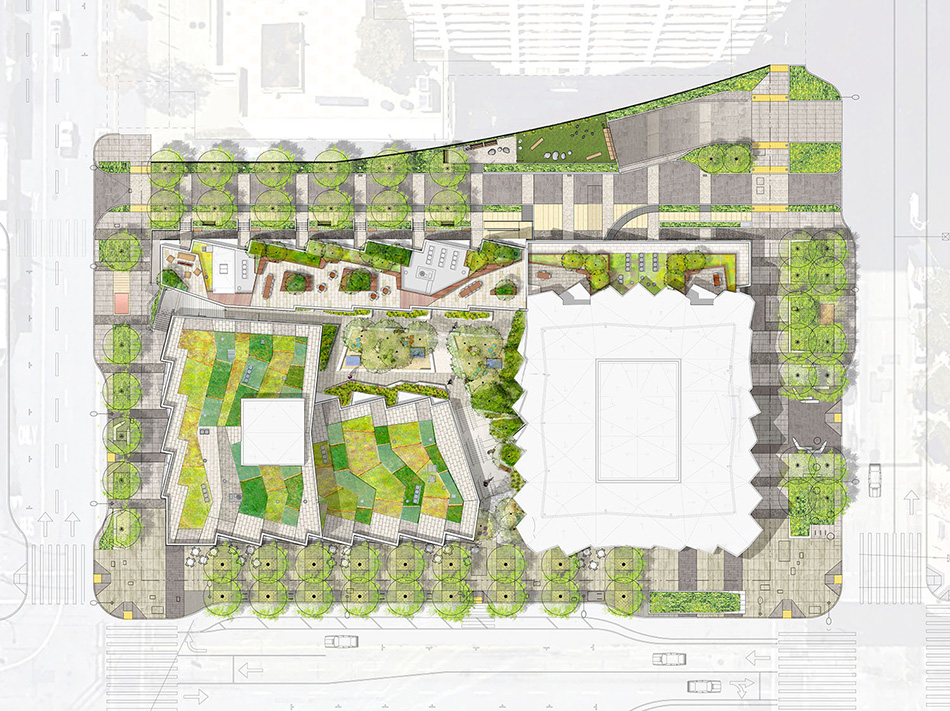
The MIRASF Landscape
There is over 54,000 square feet (over a 1 acre) of open space on 5 levels, it is a new vertical neighborhood; equivalent to 16 blocks of single family homes in a typical city, all in a one block complex. The landscape design aspires to balance human development with ecological benefit, through a shared design language of building and landscape that creates a vibrant, urban environment characteristic of downtown San Francisco, contrasting complementary spaces, both extroverted and introverted, comforting and vibrant, timeless and contemporary, diverse and simple, durable and tactile.
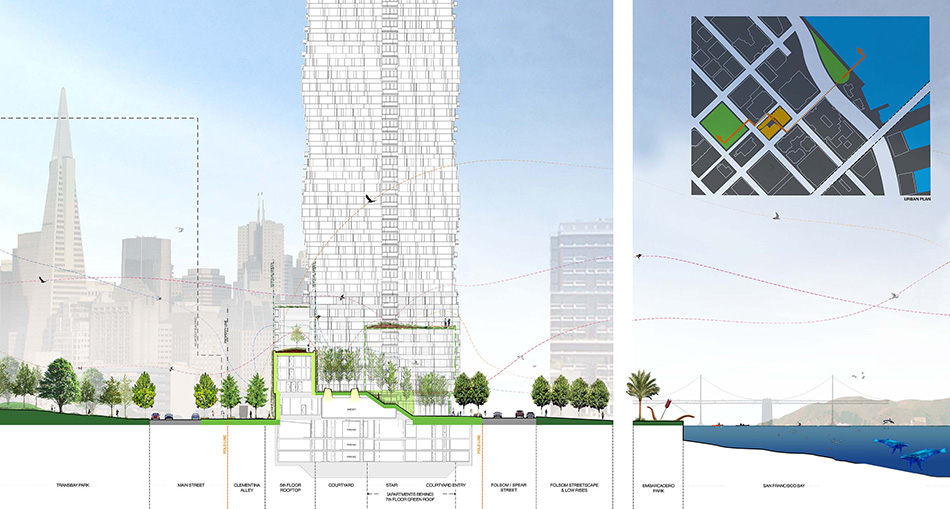 Conceptual Site Section
Conceptual Site Section
INTERSTICE’s early sectional drawing, “Ecological Corridor Concept”, illustrates the connection from Embarcadero to the Transbay Park and to the new Transit Center (Salesforce Park) beyond. The site design focuses on native species and habitat that serve native hummingbird and insect populations through careful plant species selection for food and nesting sources, and includes elements on the uppermost roofs that serve as micro-habitat, in the form of dozens of natural logs embedded in the living roofs, providing cover as they naturally decompose over time.
Streetscape
The streetscape design re-imagines Folsom street as pedestrian-prioritized boulevard with tree-lined widened sidewalks, commercial activity, rain gardens, seating, bike lanes and other amenities and safety improvements. The new Clementina Alleyway POPOS is an unusual opportunity to create an intimately scaled shared street connecting this new vertical neighborhood to the Embarcadero. A front door to new homes, this green, plant-lined habitat corridor, widens to the east, where the lane creates the Clementina Commons – an intimate open space with seating for people and their pets.
Level 2 Podium Courtyard – “The Nest”
This elevated podium-level courtyard is the protected “heart” of the residential complex with a grove of slender Himalayan Birch trees with a fern understory that is accessed from Folsom Street by a broad stair. The Tribune Stair is a series of terraced platforms that rises like a folded alleyway between building volumes, creating a terraced forest leading from the “eddy” plaza space off this busy retail corridor. This cascading landscape is an invitation to sit and linger perched where one can see the street level commercial activity.
The quiet “forest” at the foot of the Tower is the residential entry to the second level town-home units, and is a dynamic visual focus, for all the surrounding, units, town homes and tower. This green oasis of open foliage trees draw light and movement through their bright canopies deep into the space. The white birch bark and seasonal foliage reflect light and animate the court as bright green summer foliage changes to yellow in autumn, then opens up to a tracery of fine white branches through the darker winter months; lighting the lush fern understory, of textured seat walls and variegated paving stones.
Materials are soft in color, smooth and refined, with carefully detailed joints and recessed lighting with perimeter planters of lush plantings that provide privacy to surrounding living spaces, and informal seating ledges near unit entry doors. Large sky-lights connecting the indoor gymnasium below are purposefully expressed as oversize “lanterns” that emerge from below the forest floor to glow at night.
Greenroofs – “The Ledge” and “The Perch”
The upper level roofs are living roofs, that while providing a visual amenity from above, are actually very alive, and contribute a significant ecological and sustainability asset to the project. In addition to cooling the building, and extending the life of the roof, these mini habitats form part of the storm water management system by slowing and retaining rainwater. Selected species are native and adapted plants that create an ecology for hummingbirds and other native bird species, and numerous insects on down the web. Here banded patterns of varying foliage color and texture are intermixed with seasonal blooms, and divided by massive logs of wood that slowly decompose over decades to maintain plant types and enhance ecological habitat. The soil media depth of 8″ supports sedum species and smaller perennials, while deeper soils of 18″ at level 7, allow for more varied planting selections of taller sedums, grasses, shrubs and even small trees.
Level 5 Shared Amenity Space – “The Wing”
In contrast to the inner sanctum of the central court Level 5 is a more extroverted space. The Wing is the primary shared Social Gathering Space. Laid out as a linear progression of enfilade outdoor “rooms” contained within the embrace of raised meadow plantings and warm wood divider walls. The first “room” directly adjacent to the interior common lounge, is an outdoor dining area, furnished with a perimeter of large built-in benches. The next is the “entertaining” room serving flexible uses, overlooking the level 2 courtyard Birch grove, with communal tables, two outdoor kitchens, moody evening lighting and plentiful seating. The western-most “room” is a glass protected promontory with sunset view over Transbay Park. Separated from the rest of the rooms it is the most private and enclosed, for more intimate evening gatherings around a linear outdoor fireplace, with cozy furnishings and glowing floor lamps.

Location: South Market District, San Francisco
Owner/Client: Tishman Speyer / Studio Gang Architects
Scope: Landscape & Streetscape, design through Construction
Status: Completed 2020
Photography: Bruce Damonte
1567 California Street
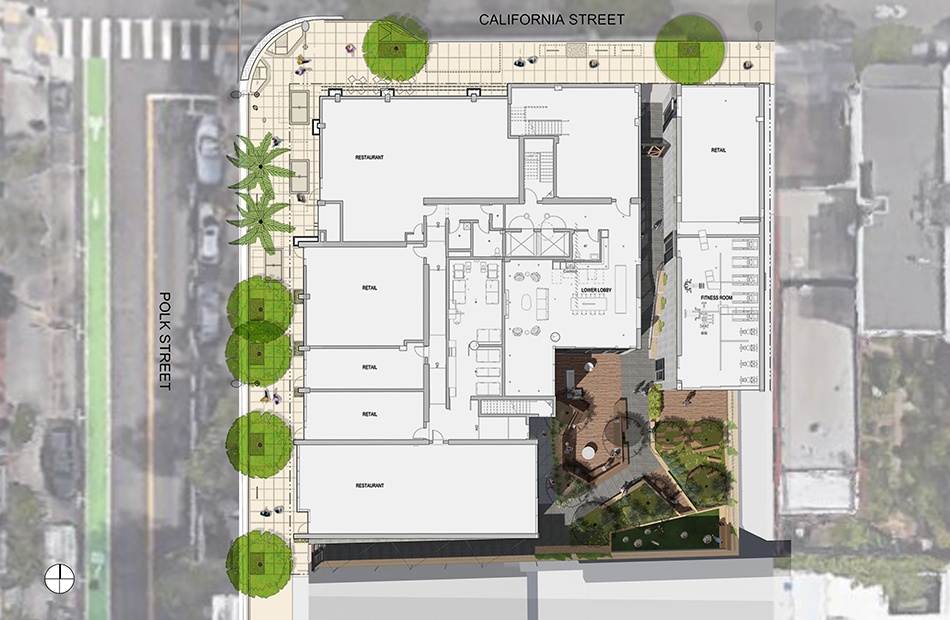
A Central Oasis
The busy intersection of California and Polk Streets is the north gate of the Polk Alleyways District, which punctuates the westernmost cable car stop in San Francisco. The landscape designed by INTERSTICE Architects complements this new, thoughtfully conceived building by David Baker. A multifamily unit residence creates our neighborhood canvas for a spacious new corner streetscape, while providing a new festoon lit alleyway access off of Polk Street that leads into a semi-private courtyard: an oasis at the center of the project.
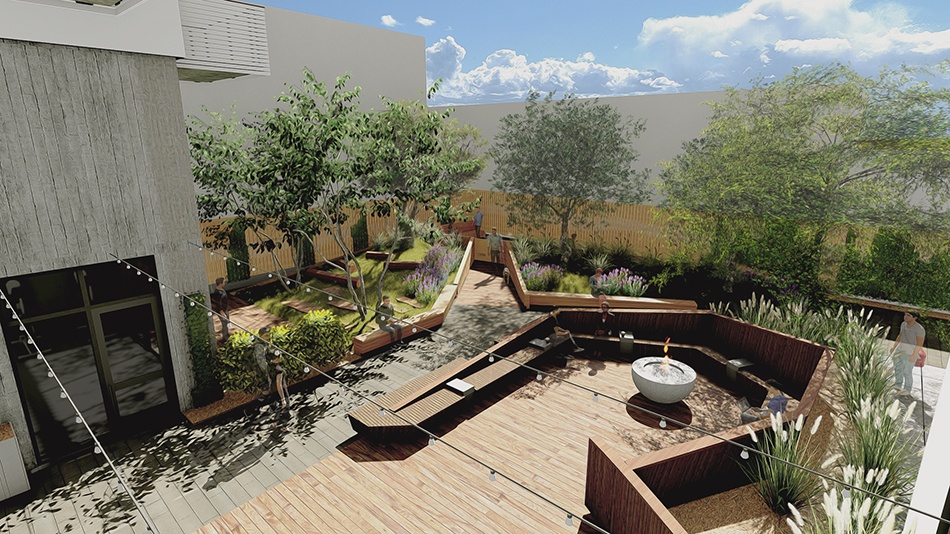
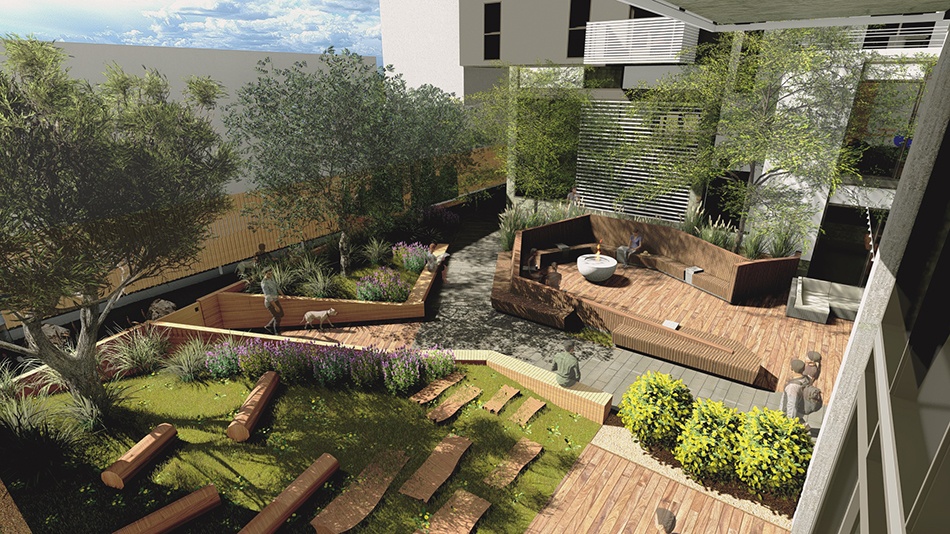
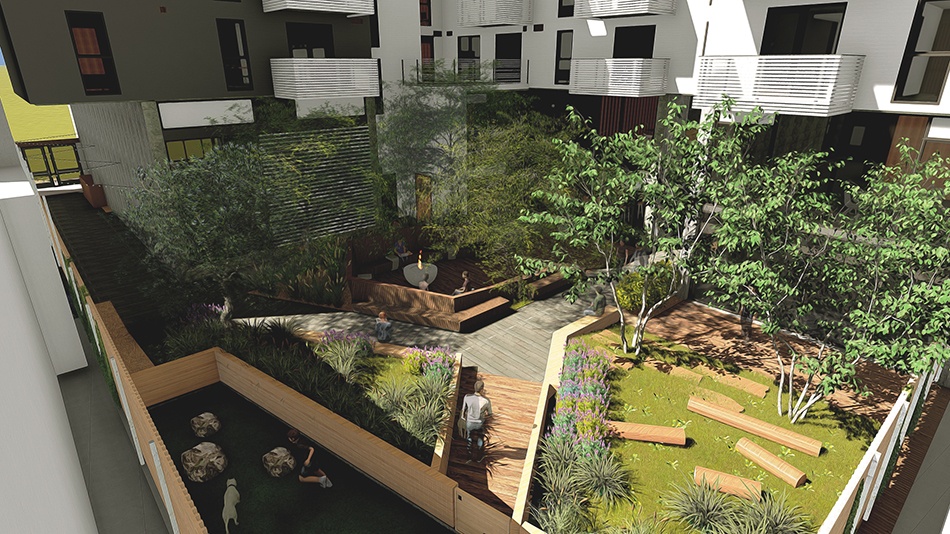
Unfolding Organization
The courtyard is a pinwheel of programs designed around a central, nest-like intimate seating element. Around this custom wood enclosure, which undulates and unfolds under a grove of deciduous trees, are organized an exterior living room space, a restaurant view-scape, a yoga studio deck, and a mini dog-run for the building’s pets. The court connects the two entry levels on this sloped site from California and Polk Streets along a second planted exterior pathway. This path ascends from the inner court though an open air atrium up a planted stairwell to reach the California Street lobby paseo.
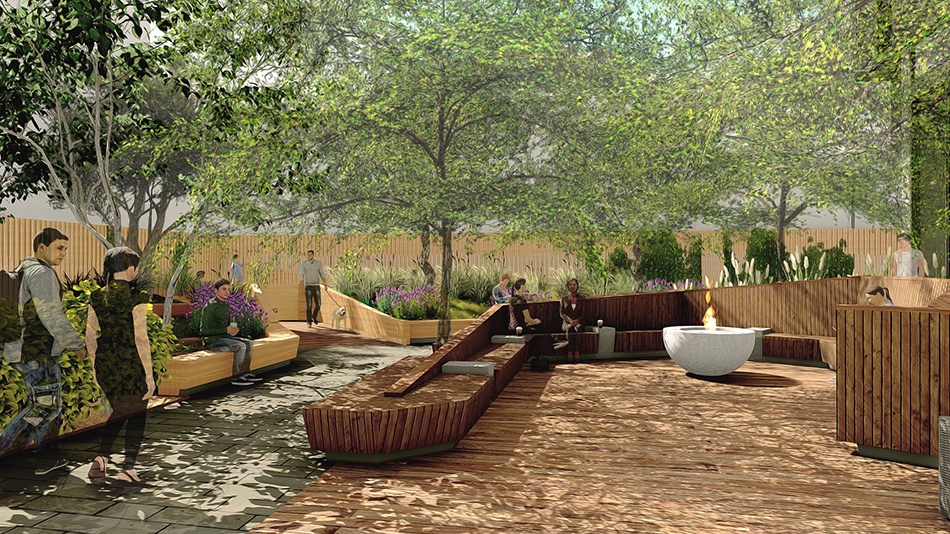
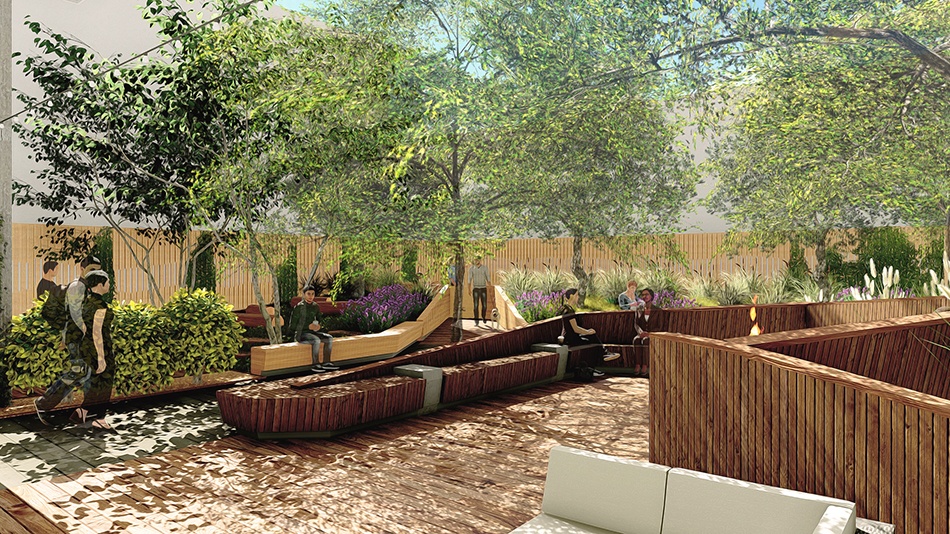
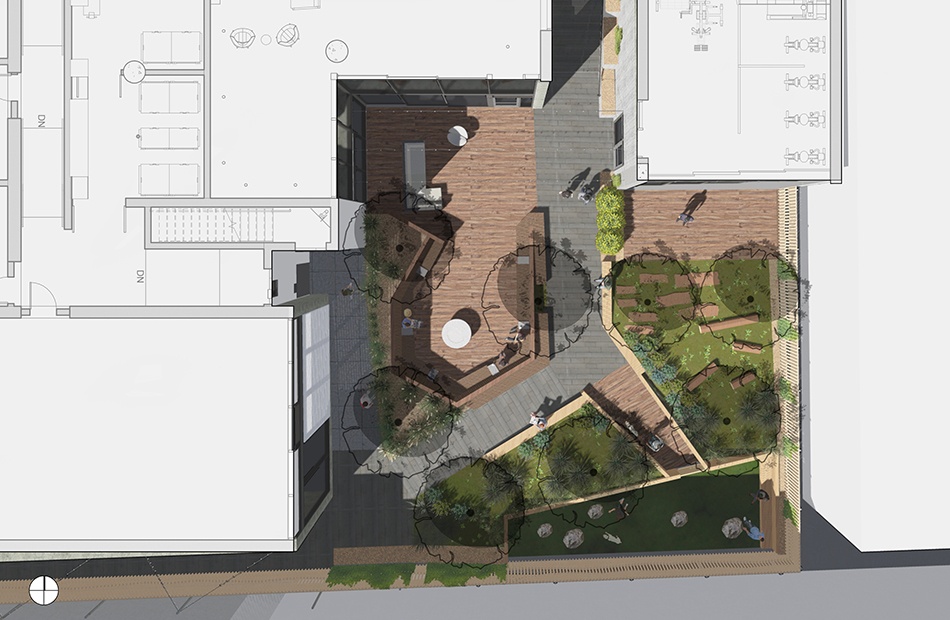
Green Meanders
Along the wire structures, vines climb to provide privacy and vertical green walls throughout the enfilade spaces. Alongside this green space, cut logs become pavers that lead the eye into the lushly planted areas meant to allow a more intimate, slow access to the courtyard complex, whether enjoying a brief pause in the space or meandering along the pathways. The grove’s shaded nest is both a furnishing and social concentrator: residents can choose to perch solitarily, or join in small groups. This quiet open space is perfect for imaginative play by the younger members of the extended housing community.
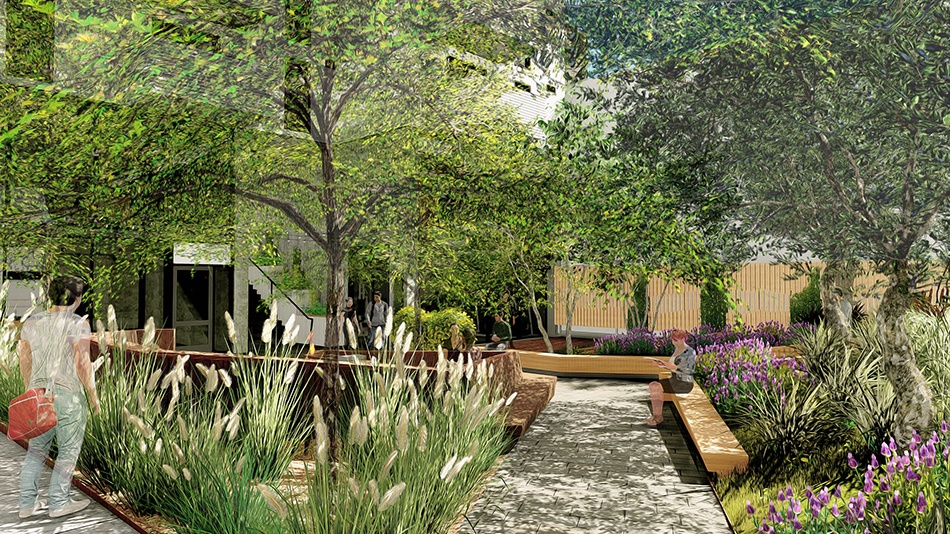
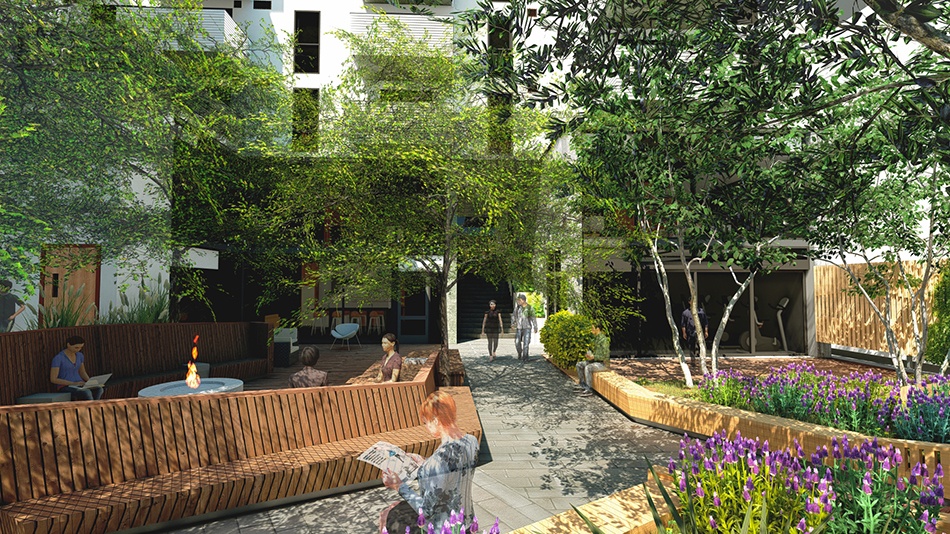
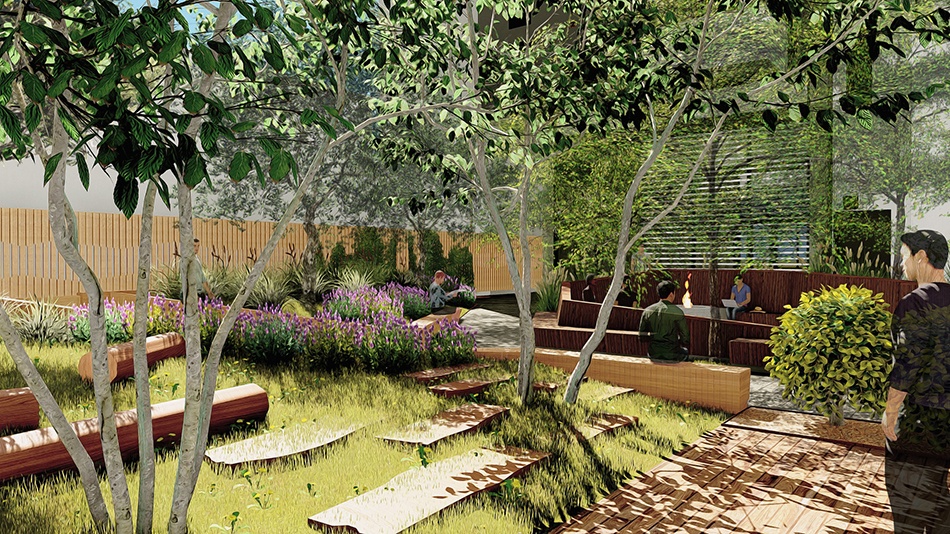
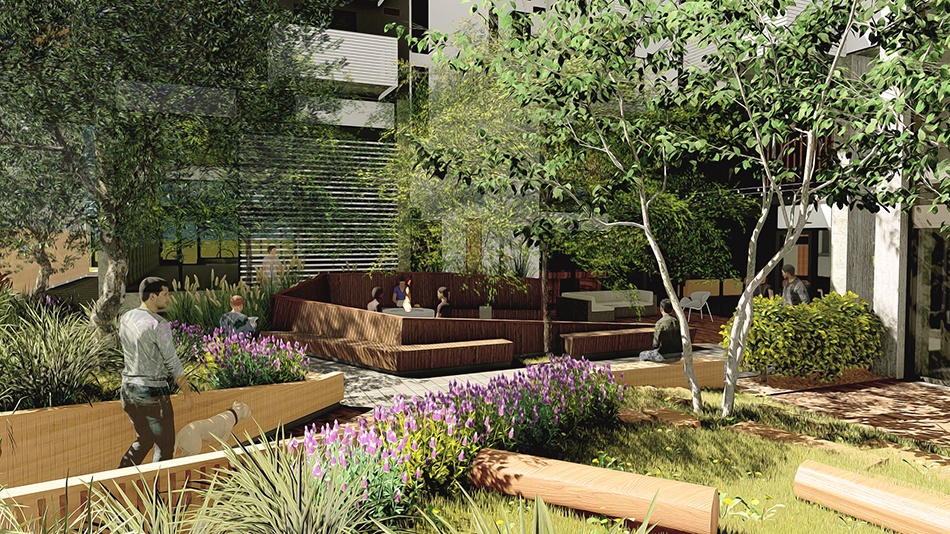
Garden Respite
This densely populated area of San Francisco is in desperate need of more green spaces. The 1567 California Street project offers a lushly intimate, park-like court that is a welcome respite from the bustling mercantile corridor just beyond the new housing project. Like a miniature Tivoli Gardens, it provides material richness and after-hours lighting to allow for an extended use into even the darkest seasons for its diverse community to enjoy throughout the year.
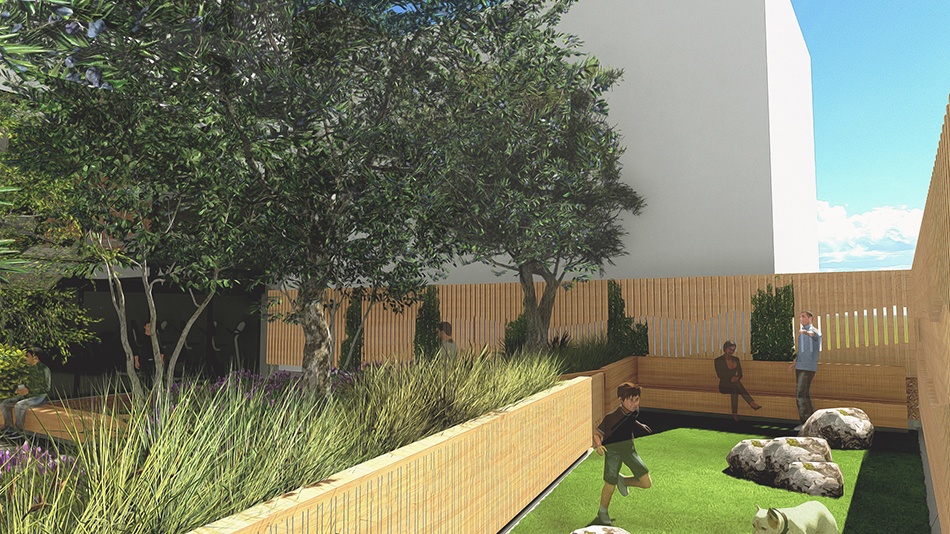
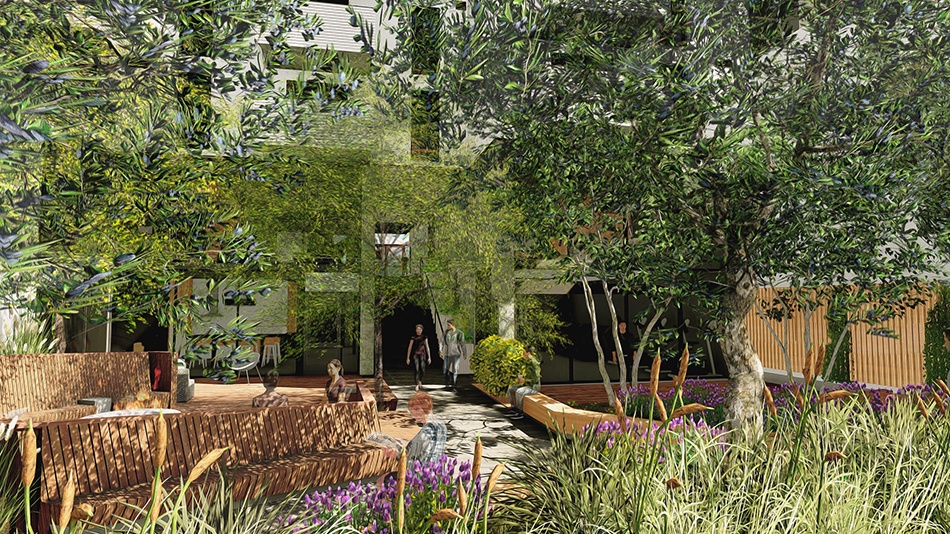
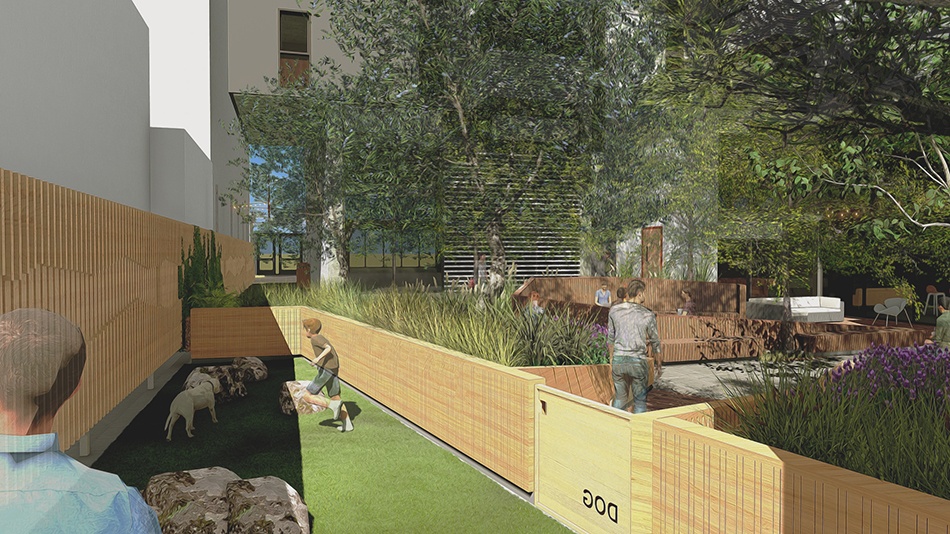
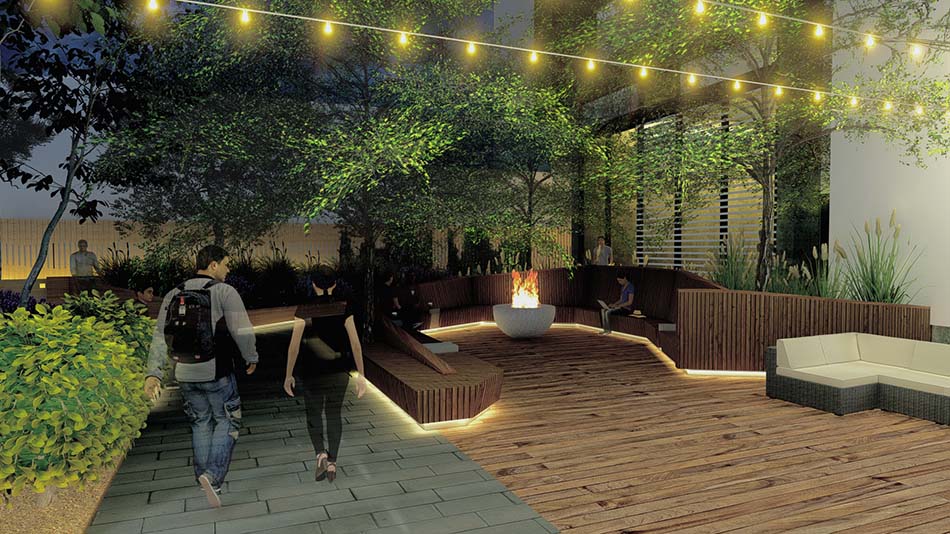

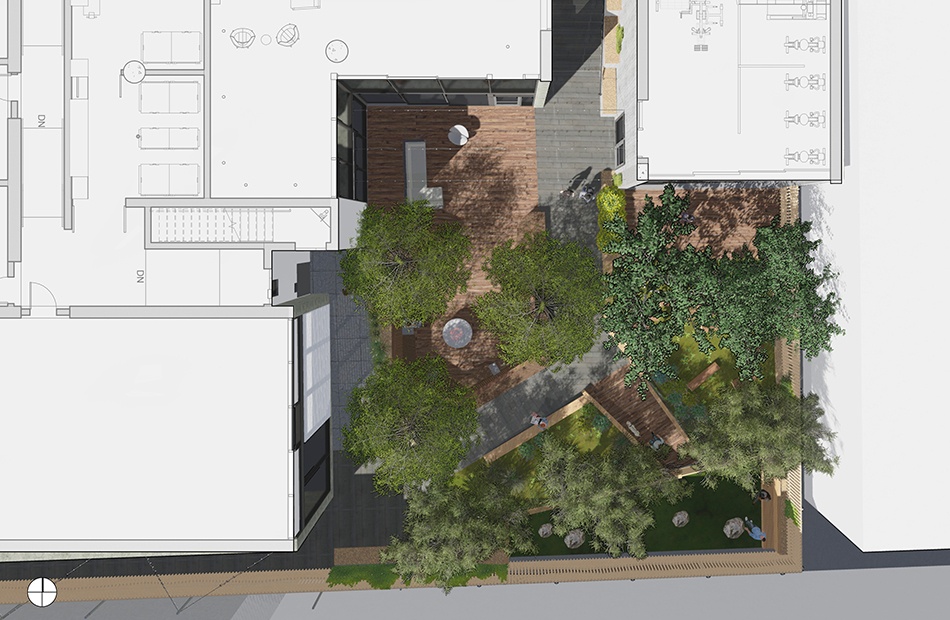
Location: California Street, San Francisco
Owner/Client: Michael Lee
Scope: Courtyard Space
Status: In Progress
Photography:
Sacred Heart Cathedral Preparatory De Paul Lobby
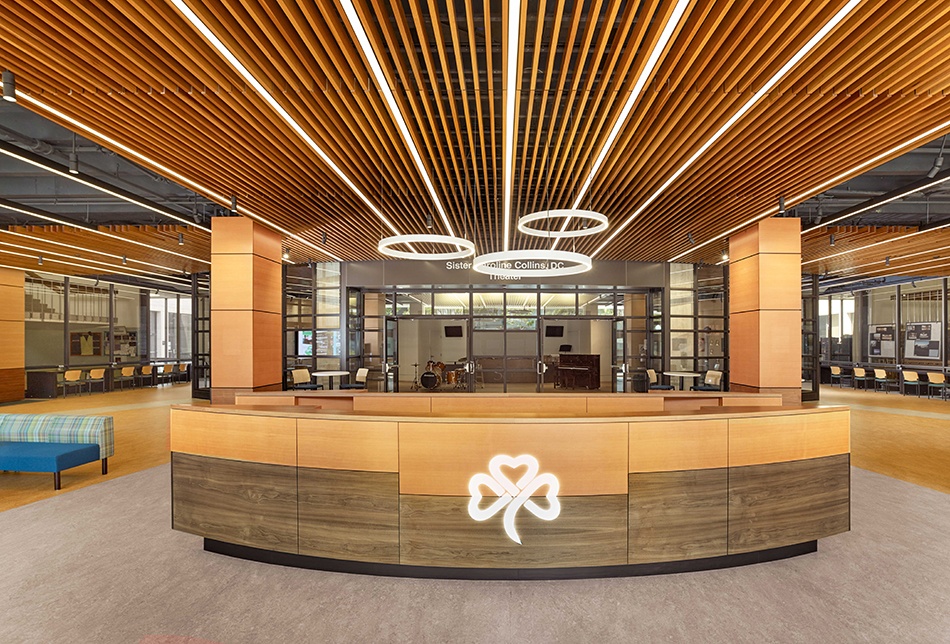
A Foyer for the Arts
The De Paul lobby needed to fulfill its role as a celebrated threshold for the Sacred Heart Cathedral Preparatory’s (SHCP) arts campus. Located on the corner of Ellis and Gough Streets directly beneath the iconic Cathedral of St. Mary of the Assumption, this formerly exterior in-between space is a crucial conduit from the surrounding community to the hub of the school’s Arts and Humanities campus. Building into the new masterplan, INTERSTICE Architects transformed the formerly cold, open-air lobby from a leftover space into a welcoming and collaborative student-centered gallery—a foyer for the arts, students, and the SHCP community—to more actively engage with one another in a creative learning environment. The gallery, with its new identity, is a flexible communal place that is a nexus for teachers, parents, and students to gather, share, and exhibit their creative work.
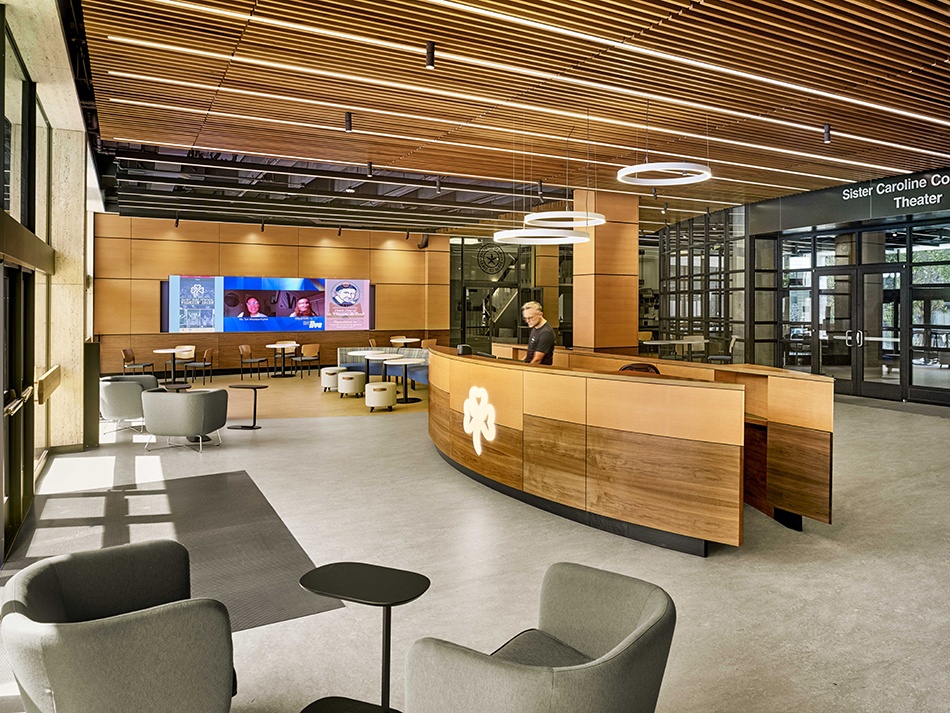
From Space to Central Place
The new vision for the lobby called for creating place—a place of engagement, collaboration, and education. This required an evolution of the space from its original conception. Before INTERSTICE came onto the project, the De Paul lobby was an open-air, exterior courtyard structure, which funneled students and visitors into the campus by passing a small security desk parked in one corner of the drafty, cold, and hard space. One’s first impression of SHCP’s arts campus had previously lacked artistic expression: it was an in-between, a space to be passed through rather than remain in. By enclosing the lobby and adding warm and articulated wood, enhanced lighting, texture, and color, INTERSTICE reimagined the space, giving it an entirely new identity appropriate to the daily needs of a bustling, artistic student body—one that bolsters the school’s storied history within the city and its celebrated musical theatre productions.
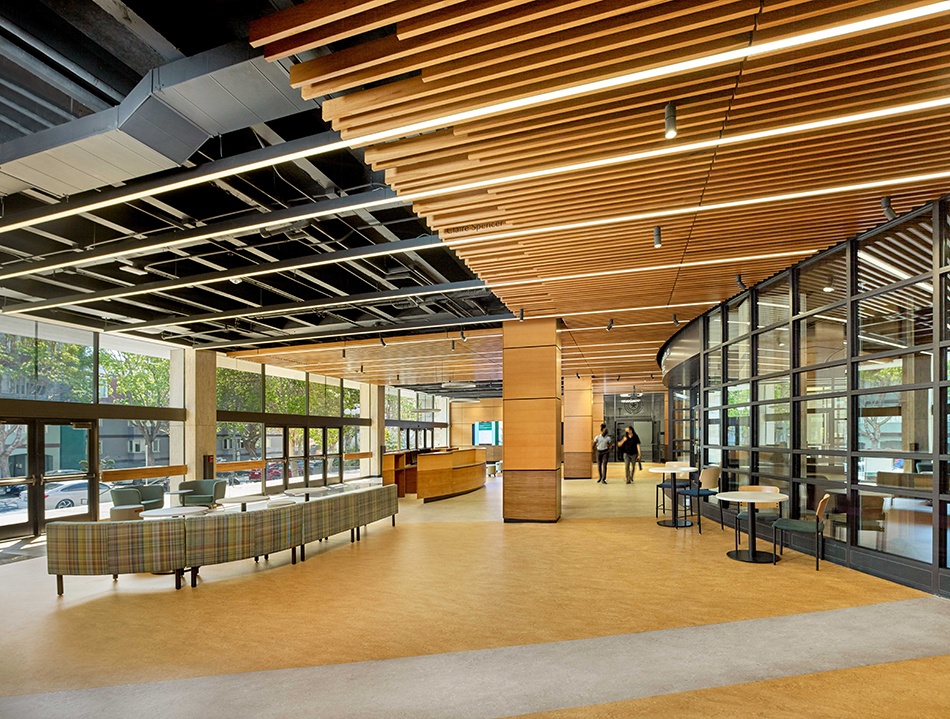
Intertwined with the City
The history of SHCP is deeply rooted in San Francisco. What was once two separate Catholic educational institutions founded by the Daughters of Charity and the Christian Brothers in the mid-1800s is now Sacred Heart Cathedral Preparatory. The two schools officially merged in 1987, officially creating SHCP, a school now known throughout the Bay Area for its keen focus on educational excellence.
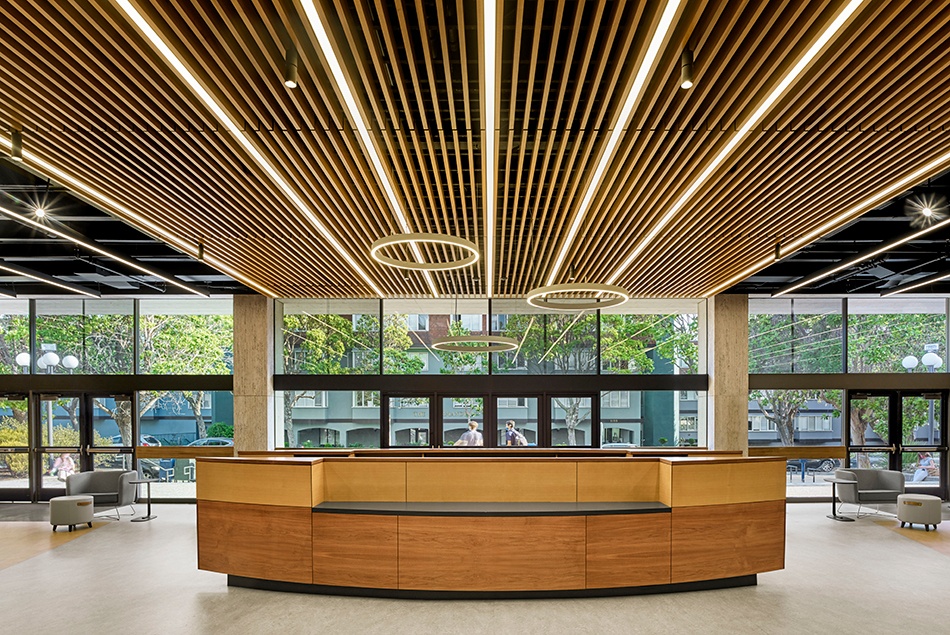
The Multi-Purpose Gallery
The redesigned De Paul lobby offers visitors a more engaging and welcoming first impression coupled with the flexibility of a multipurpose educational hub. The natural wood material, bright linoleum floors, and layers of use-specific lighting combine to create comfortable and warm reception within an informal modern classroom/gallery setting. Community table areas and comfortable seating, clustered together in team breakout workstations, facilitate the lobby’s use as a collaborative teaching space, while acting as SHCP’s main foyer for the Arts. The new multipurpose lobby is now the De Paul Campus gallery for the students’ artwork, from visual and costume designs, along with graphic arts, to an impromptu film screening location, complete with AV multi-screen compatibility. The design of the space maximizes how the SHCP students can showcase their work to other students, parents, guests, prospective students, teachers, and alumni, creating a welcoming environment for all, with a deeper connection—past, present, and future—to the school’s creative heart.
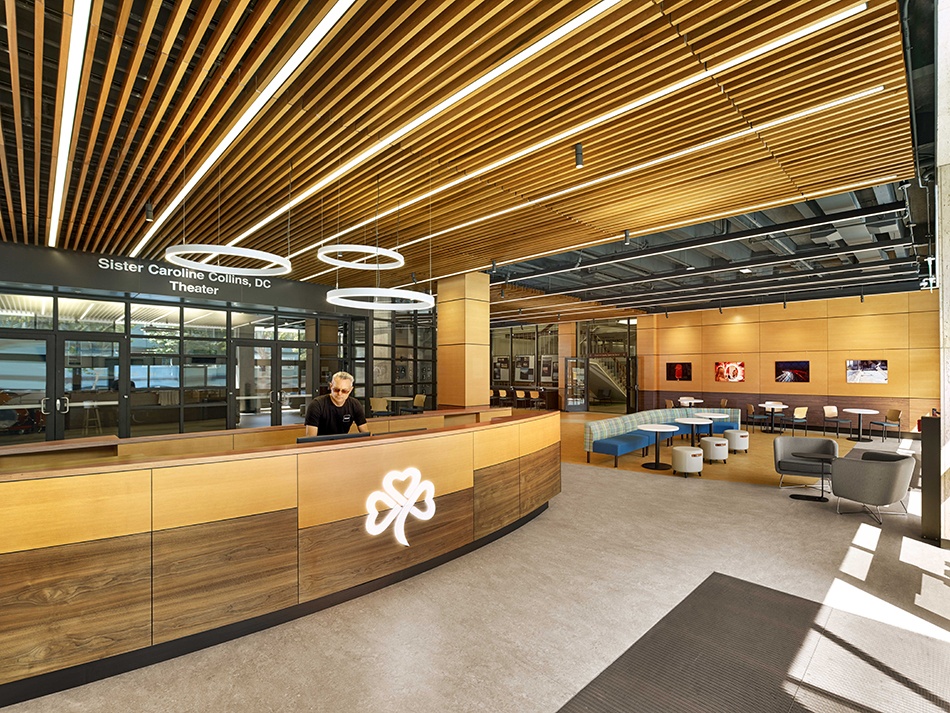
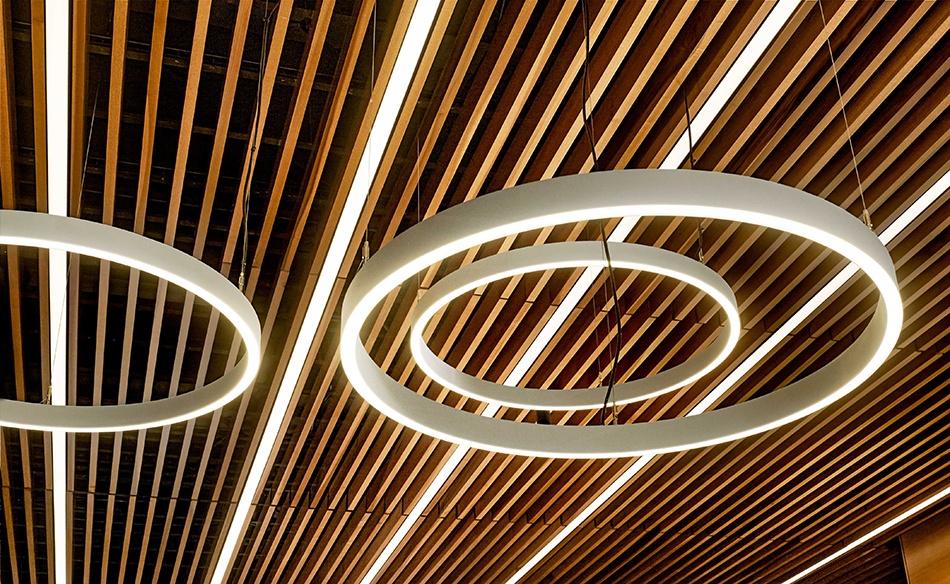
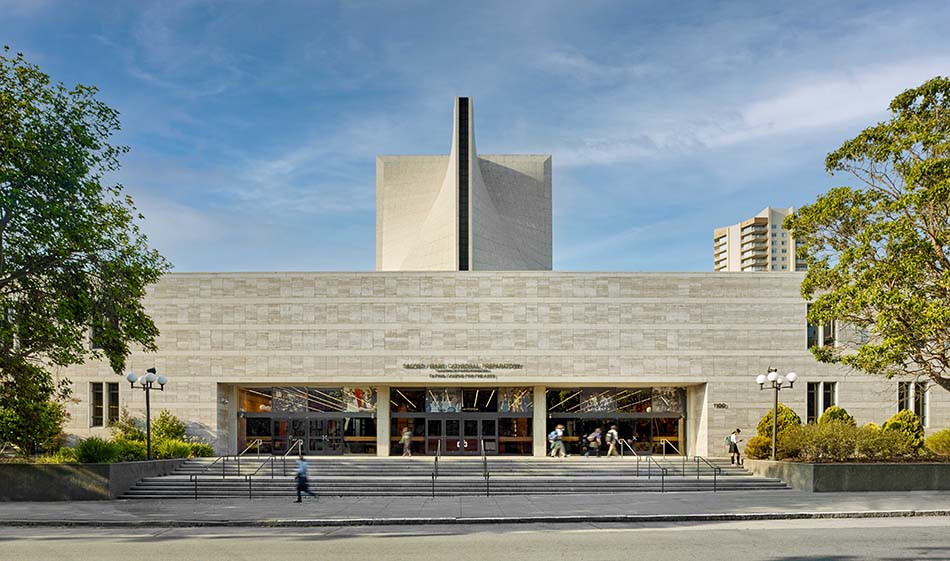
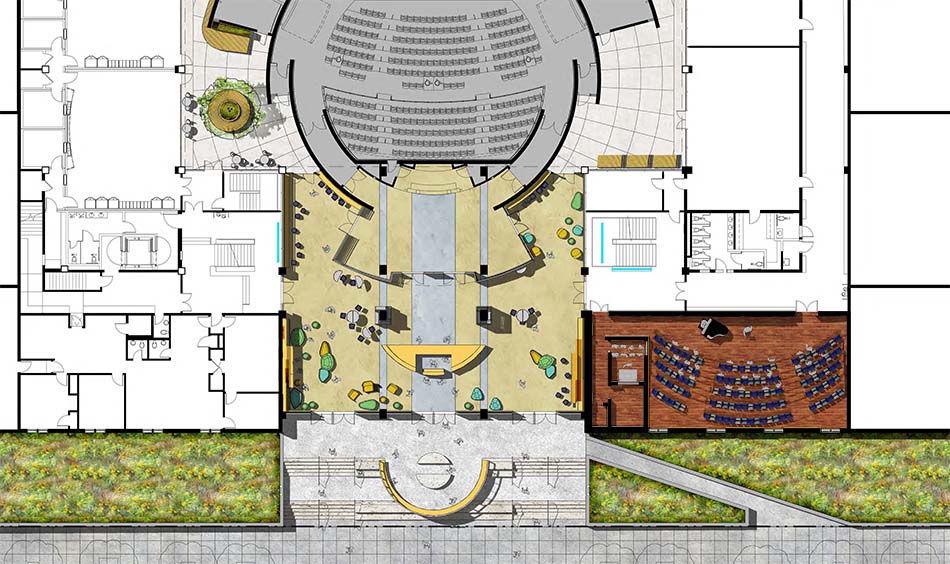
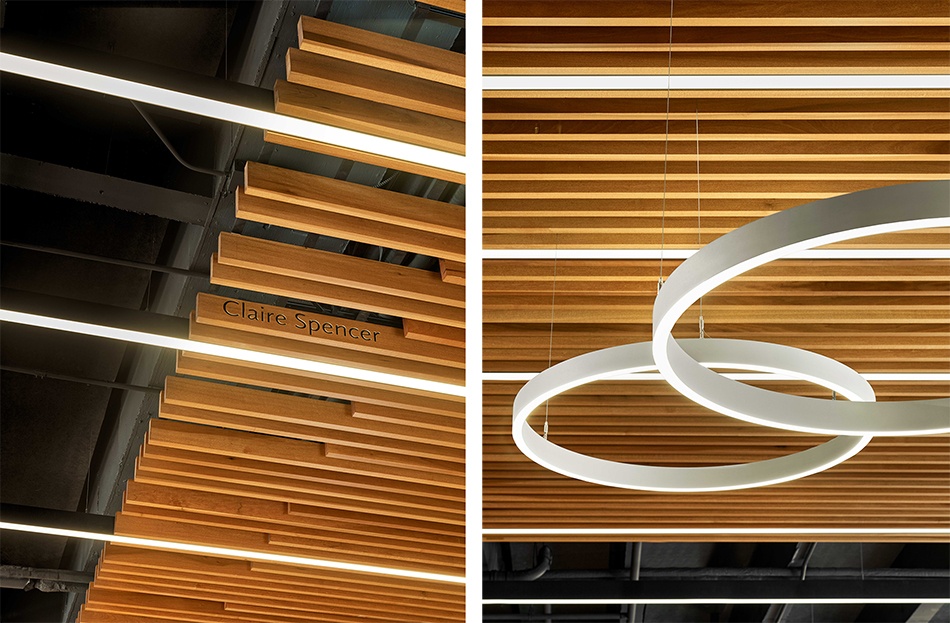
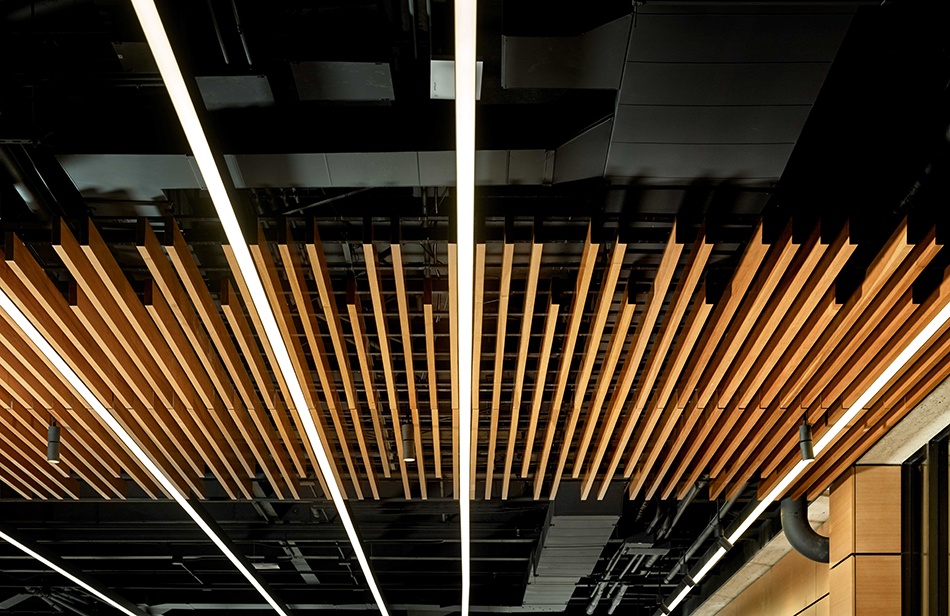
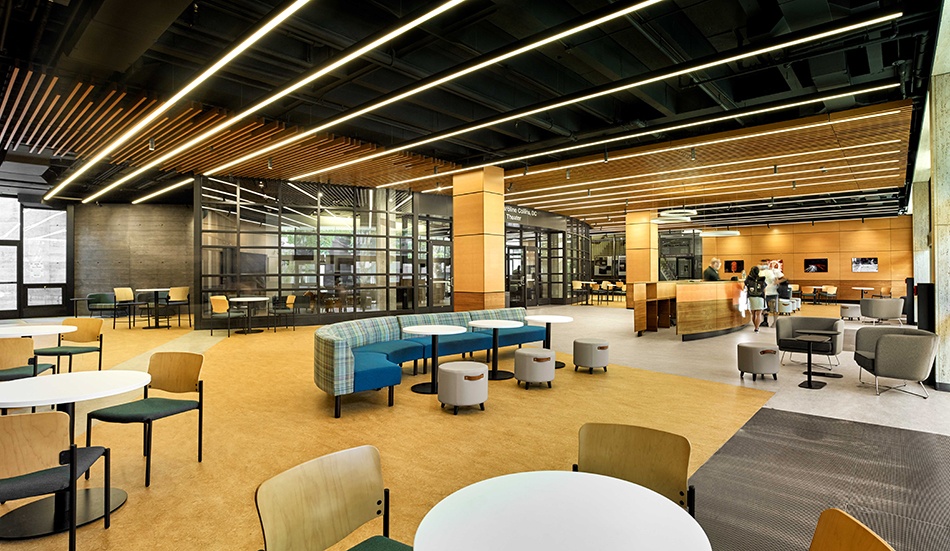
Location: Cathedral Hill, Western Addition, San Francisco
Owner/Client: Sacred Heart Cathedral Preparatory School
Scope: Academic Building Renovation
Status: Completed
Photography: Cesar Rubio
KQED Headquarters Renovation
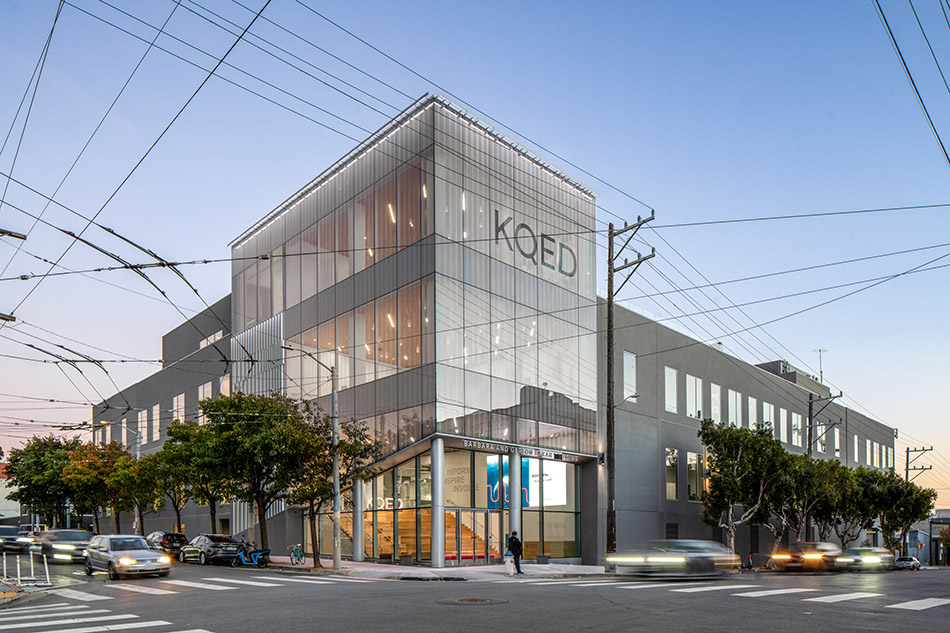 Photography Jason O'Rear
Photography Jason O'Rear The Power of Transparency
Northern California’s beloved public media outlet, KQED’s newly renovated headquarters based in San Francisco’s Mission District neighborhood. INTERSTICE is working with the architecture team led by EHDD to create a publicly oriented streetscape and a new lobby that welcomes the community, providing a new street-facing amenity to the neighborhood, visitors, and staff of KQED. Additionally, INTERSTICE designed an outdoor rooftop terrace with a sweeping view of downtown San Francisco. It will be used 24/7 by staff as an outdoor informal meeting and break space, and will serve as a special event space for the KQED community.
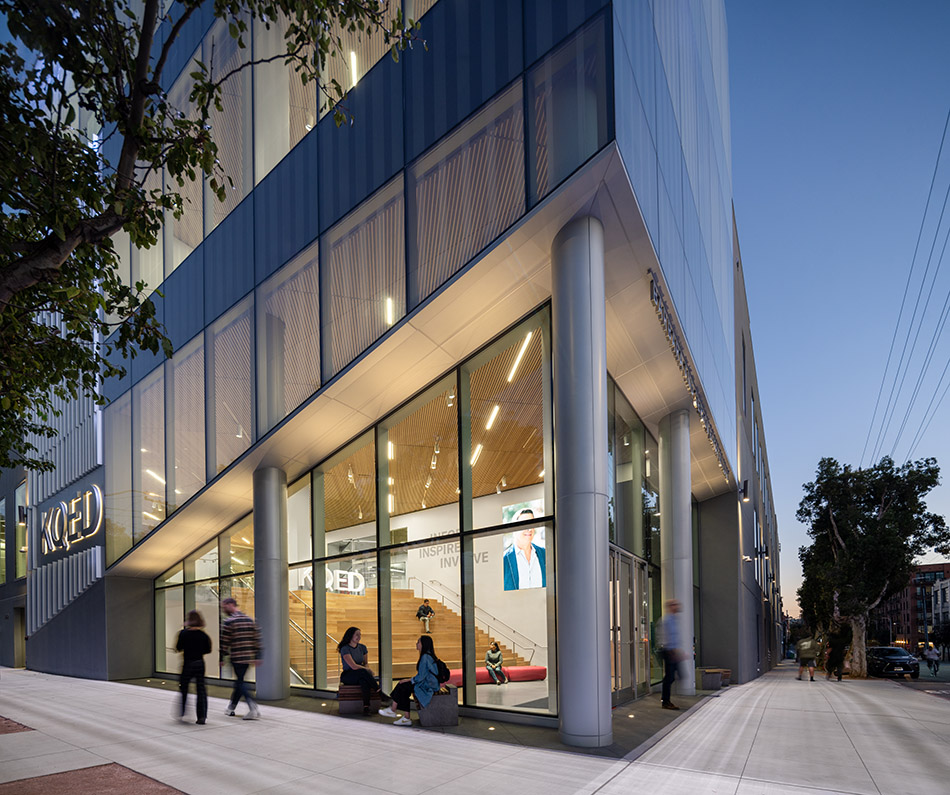
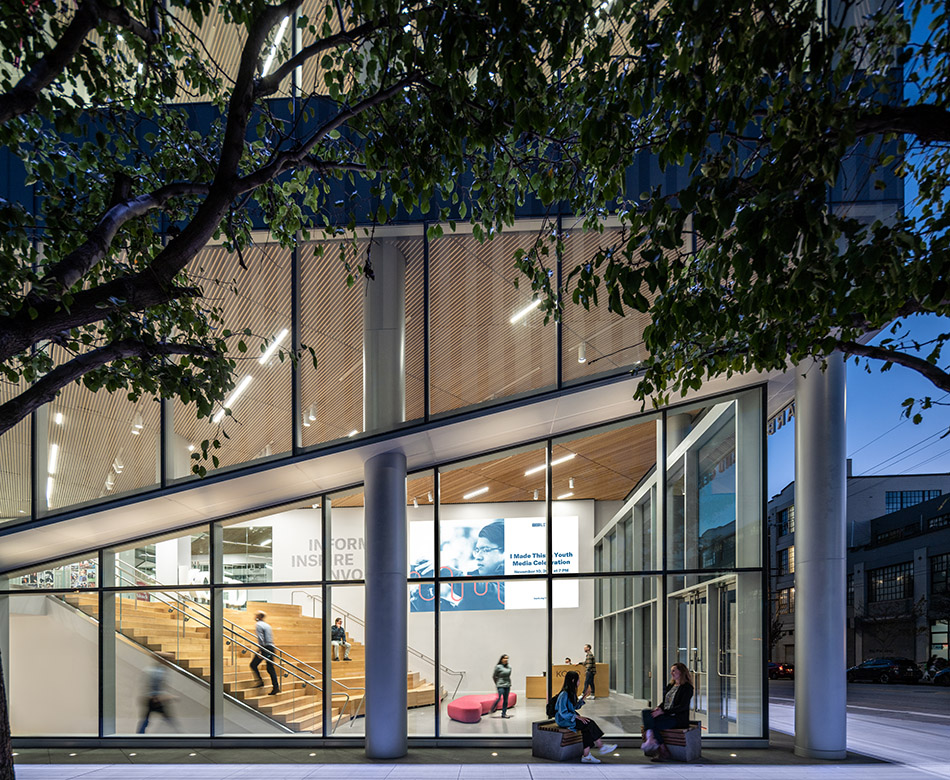
Invitation to the Community
The new design transforms KQED’S presence at Bryant and Mariposa Streets to make this corner the focal point of the block and emblematic of KQED’s engagement with their community. A primarily glass facade provides visual connection between the street and the entry lobby, where this new bright lobby space features a stepped seating amphitheater that is open to the public. The lobby is complemented by streetscape furnishings that reinforce the publicness of these two newly connected spaces.
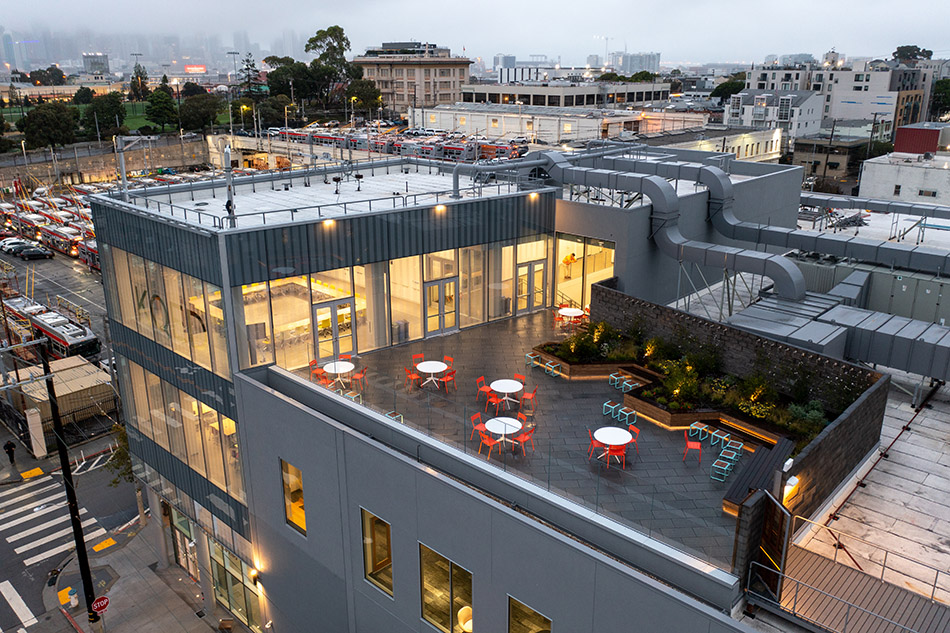
Rooftop Hub
The new roof terrace is created as an exterior environment for staff—an outdoor space for breaks, impromptu meetings, and staff events, as well as a place for the Board of Directors to gather, and for fundraising and public events. The roof terrace has a 360-degree view of San Francisco—including downtown, Twin Peaks, and Bernal Heights—with the design integrating wind protection, seating, native plantings, and colorful and moveable furnishings to accommodate various daily activities. The terrace’s design concept is to provide both smaller outdoor rooms created within a planted edge and a flexible-use central space for larger events and gatherings.
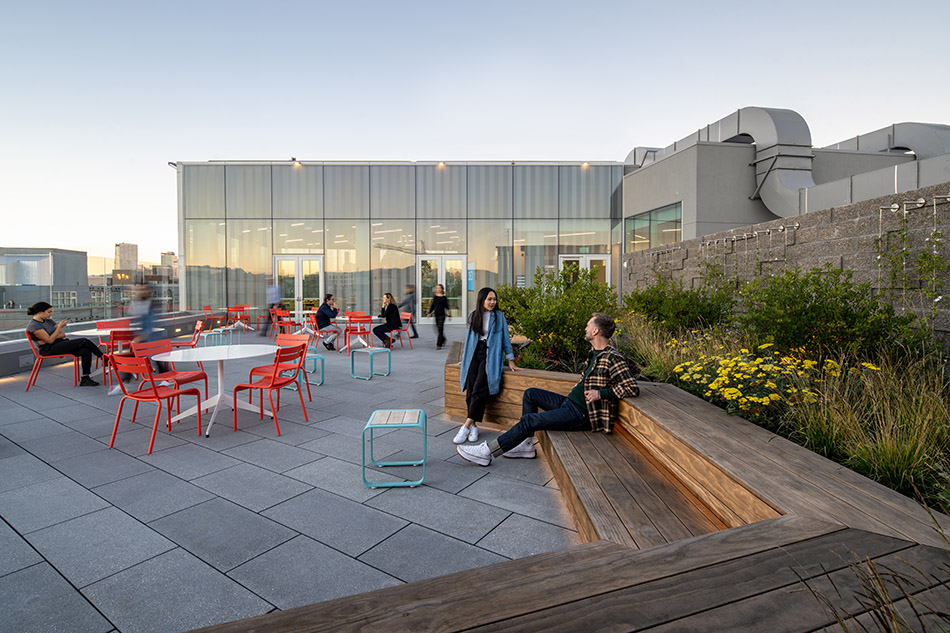
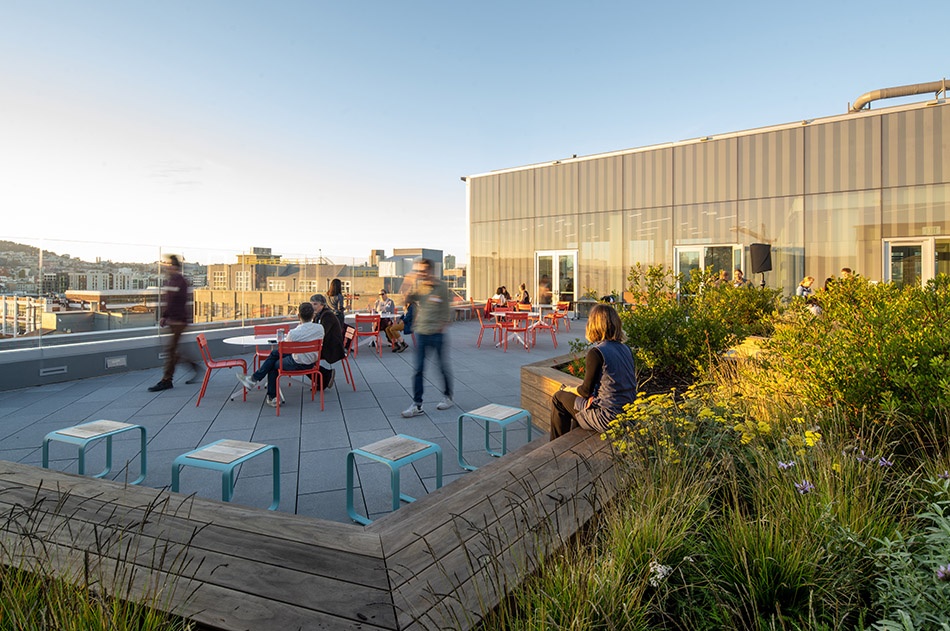
The primary design element is a lengthy, raised planter that runs along the east edge of the terrace, with a surrounding screen wall to separate the terrace visually and acoustically from the adjacent roof and its mechanical structures. The built-in raised planter has niches for seating and a raised terraced edge to the south that accommodates a stepped, amphitheater-like seating edge for small groups. The screen wall has a sculptural, woven block texture and panels of vine climbing cabling to create a vertical green backdrop to the terrace. Plantings have been selected to create bird and butterfly habitat with an emphasis on native flowering species.
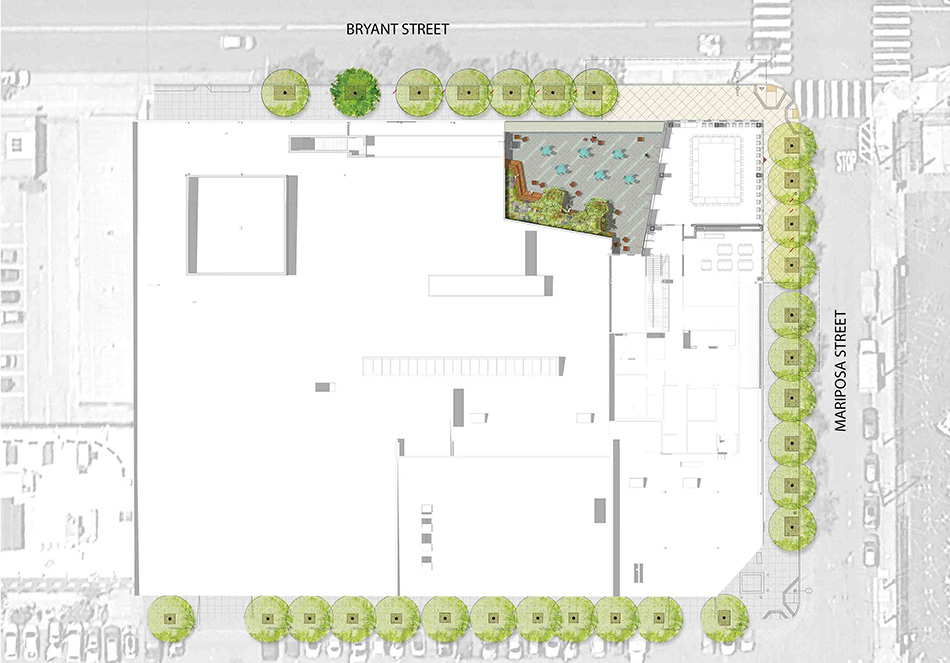
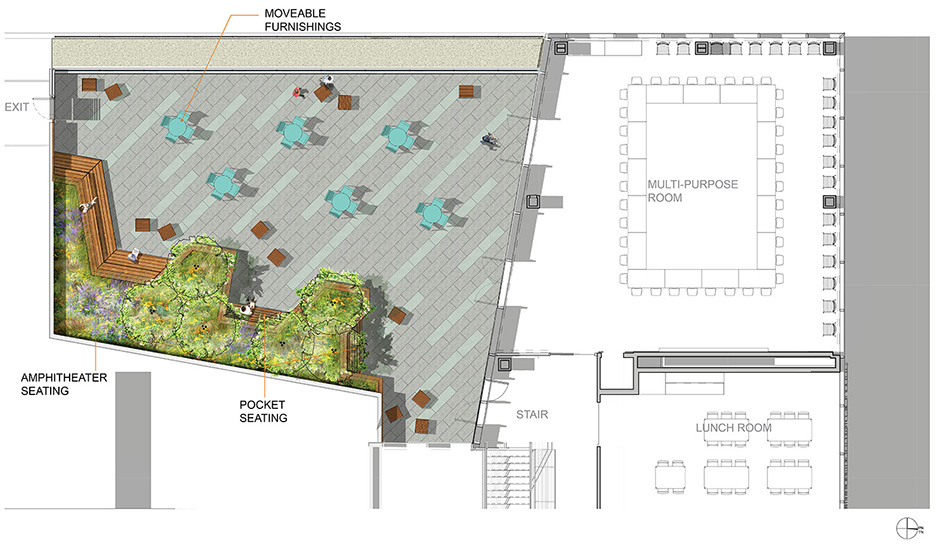
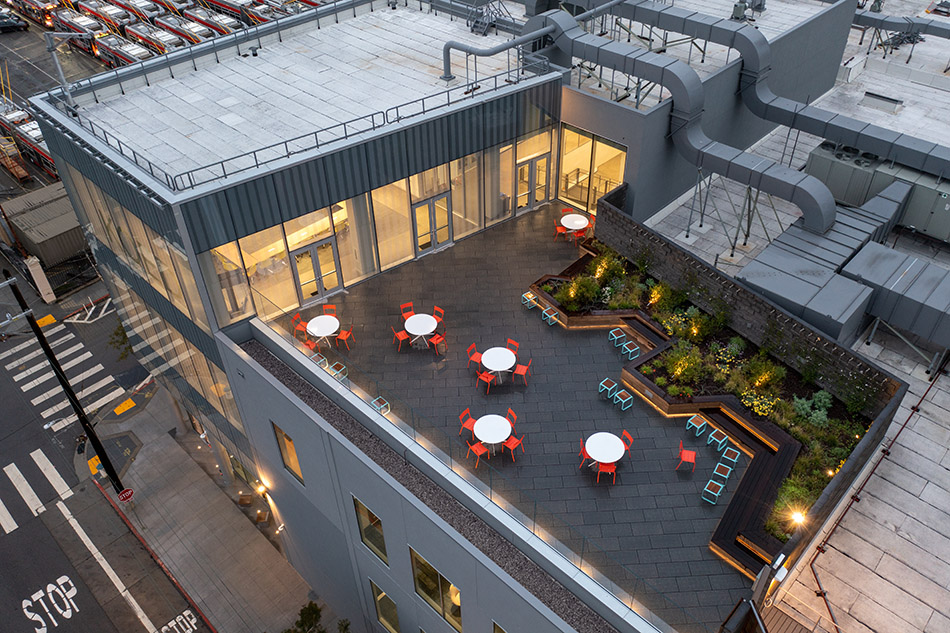
Public Geometry
With KQED being a public media outlet squarely at the intersection of art, politics, and culture, it seems fitting that their new headquarters are geographically oriented towards the intersection of two busy thoroughfares in the Mission District. With this reorientation in mind, the architects on the project decided to add details into the design of the building and the multipurpose terrace that are also oriented towards the corner of Bryant and Mariposa Streets including the terrace planter geometry, the rooftop pavers, the lobby and workspace lighting, and boardroom flooring, all of which are aligned on a 45° angle that brings the geometry to the corner of the building, and creates an outward-facing, thematic grain to the project.
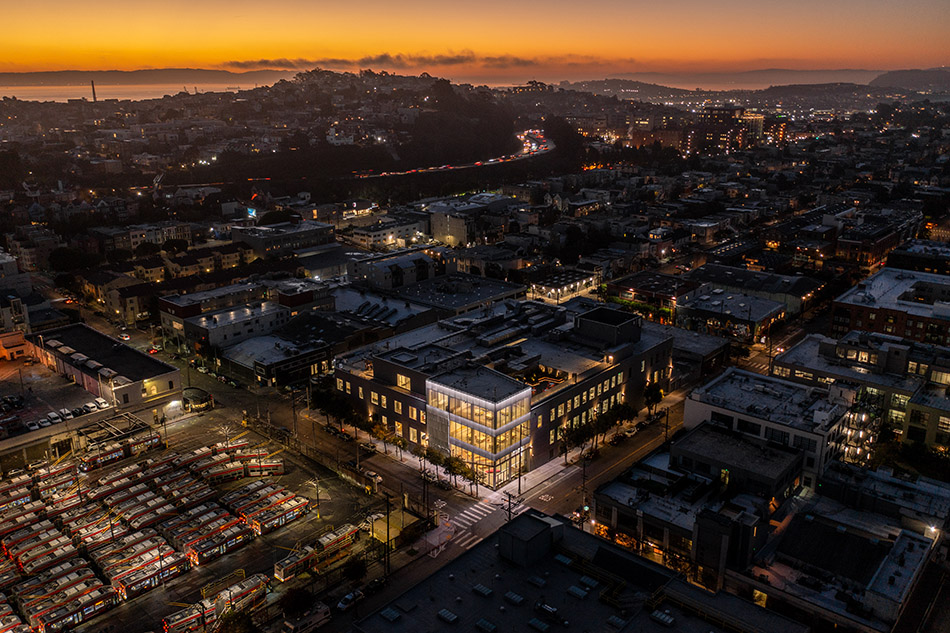
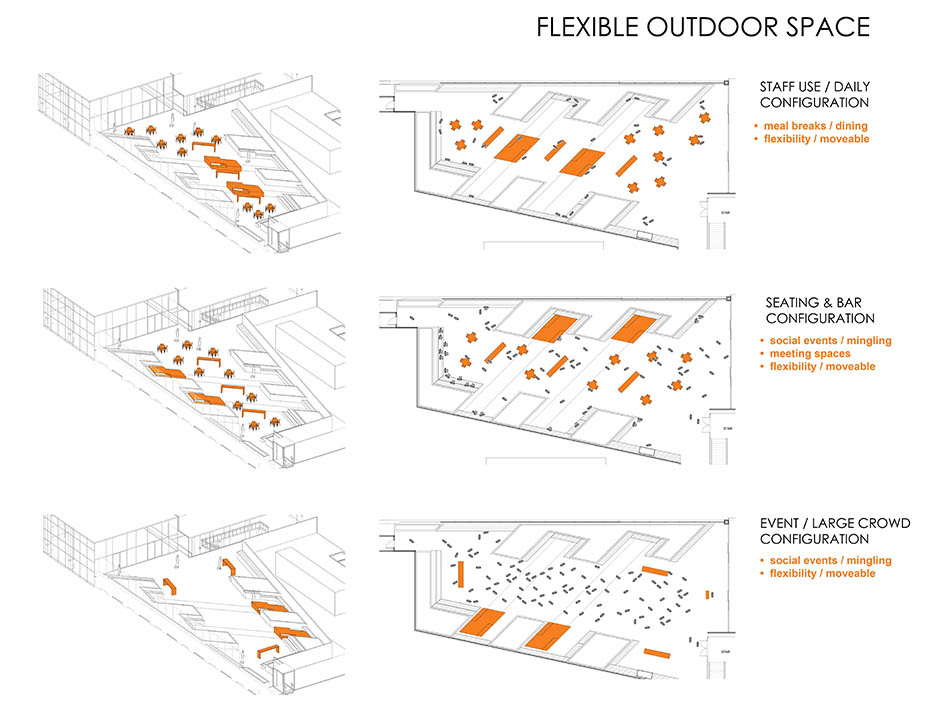
Program/Use Study
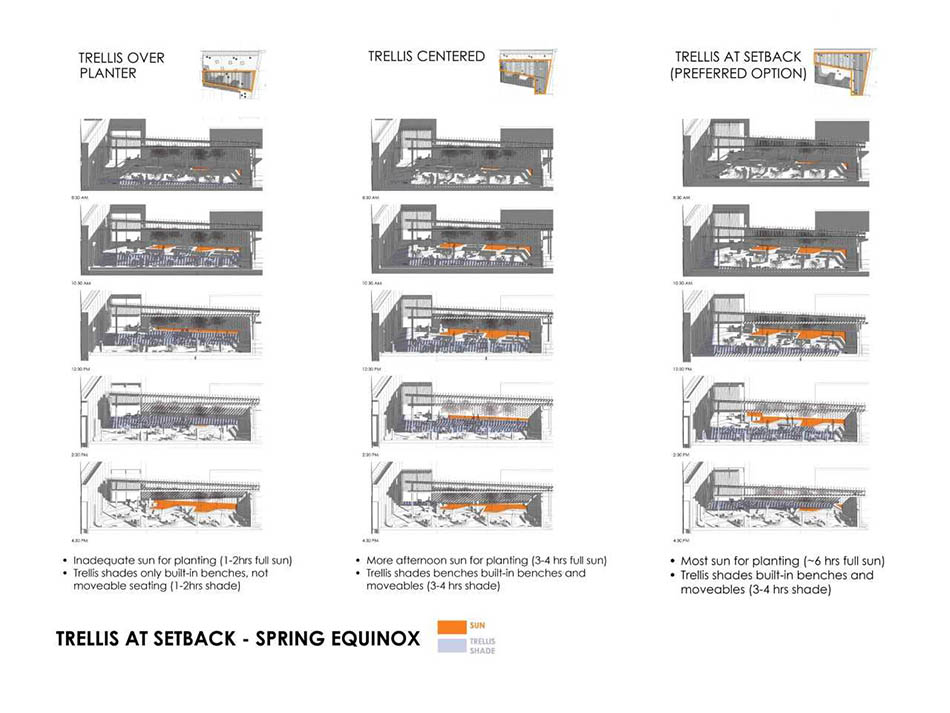
Trellis Form Study
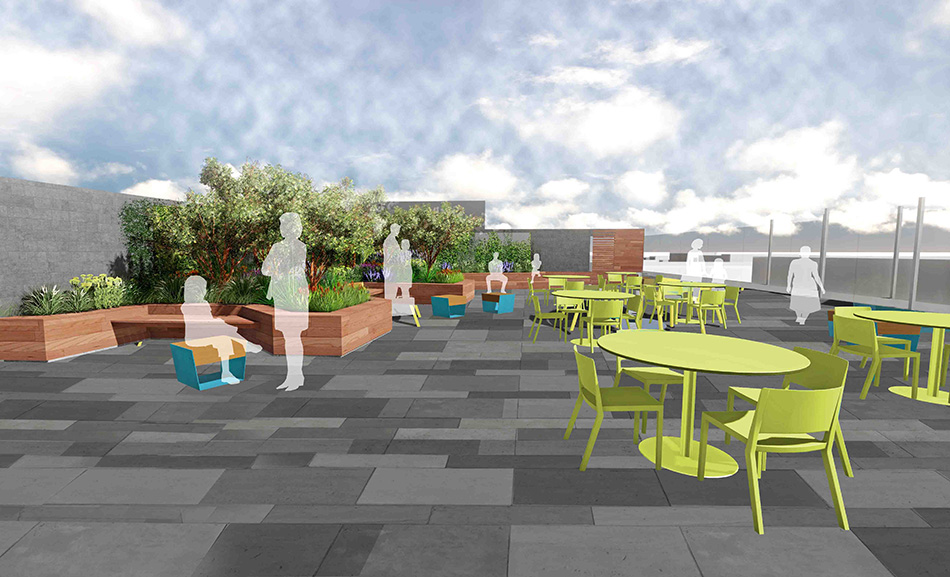
Location: Mission Neighborhood, San Francisco
Owner/Client: KQED / EHDD
Scope: Roof Terrace & Streetscape
Status: Completed 2021
Photography: Jason O’Rear
Stanford Public Safety Building
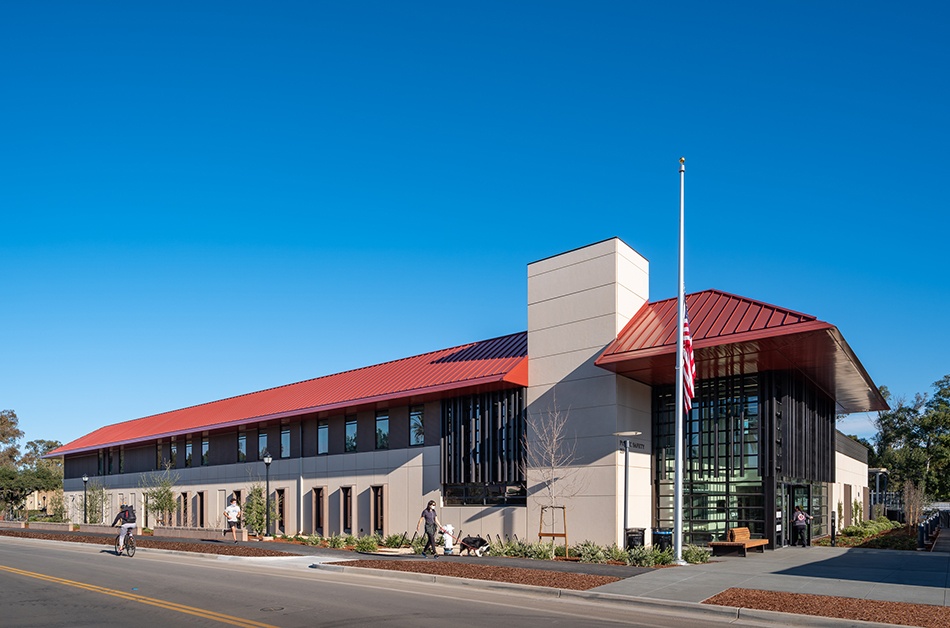
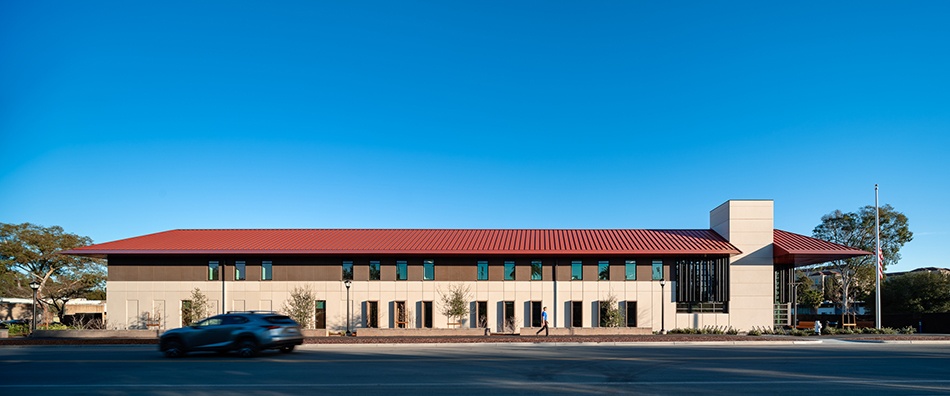
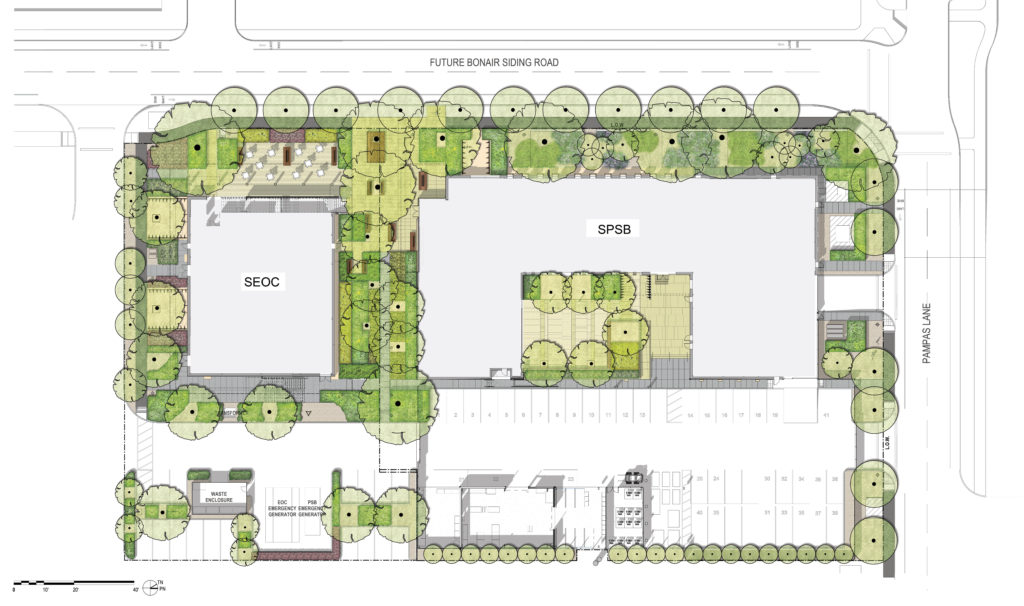
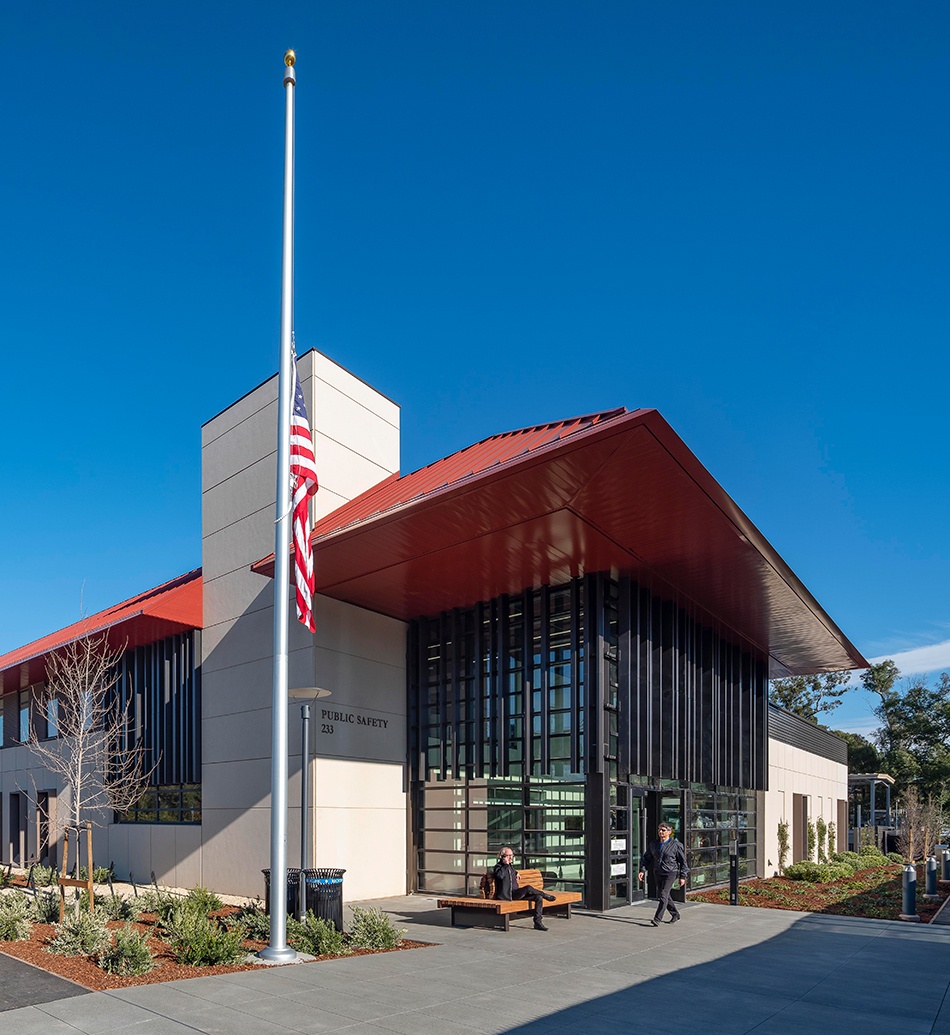
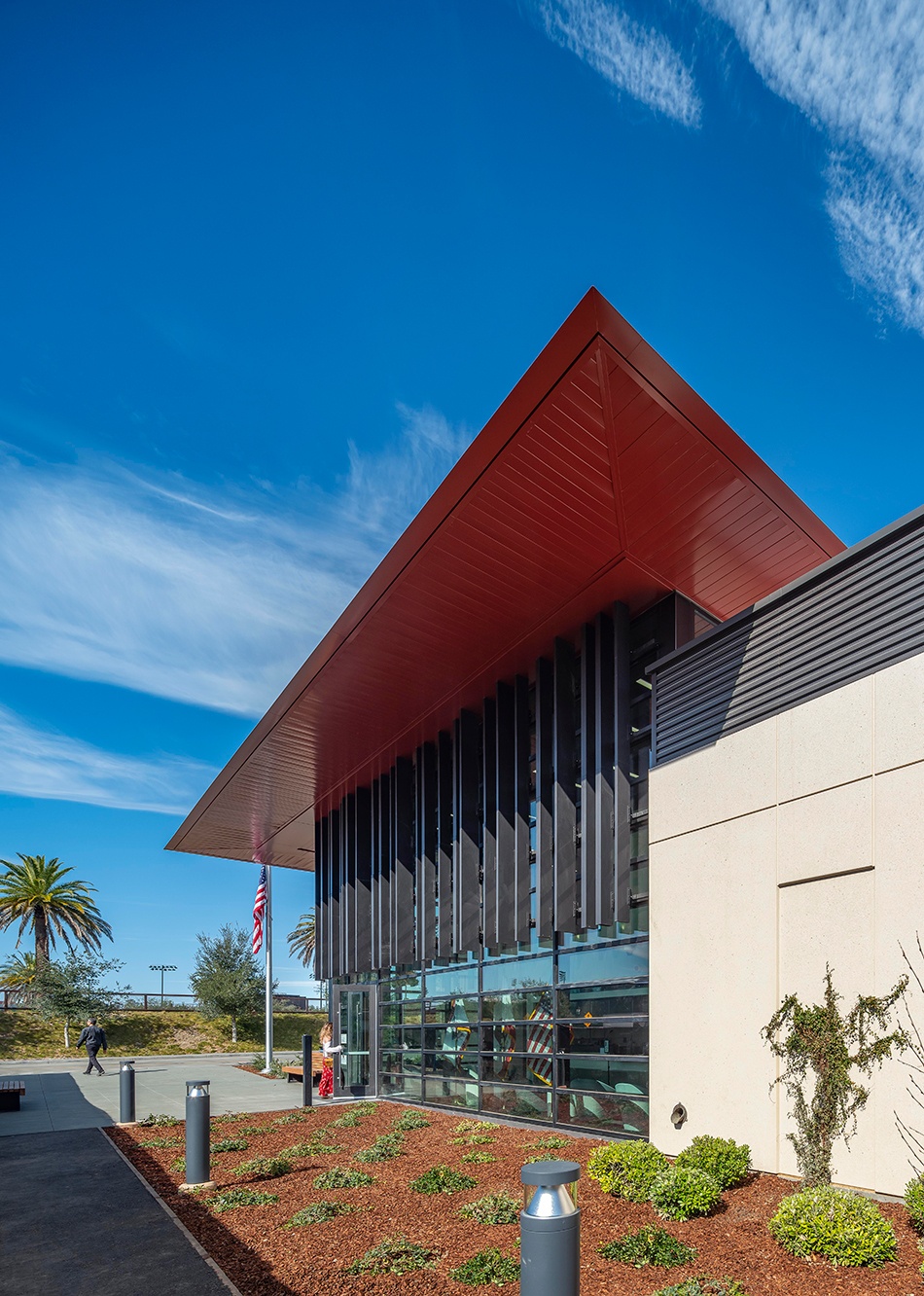
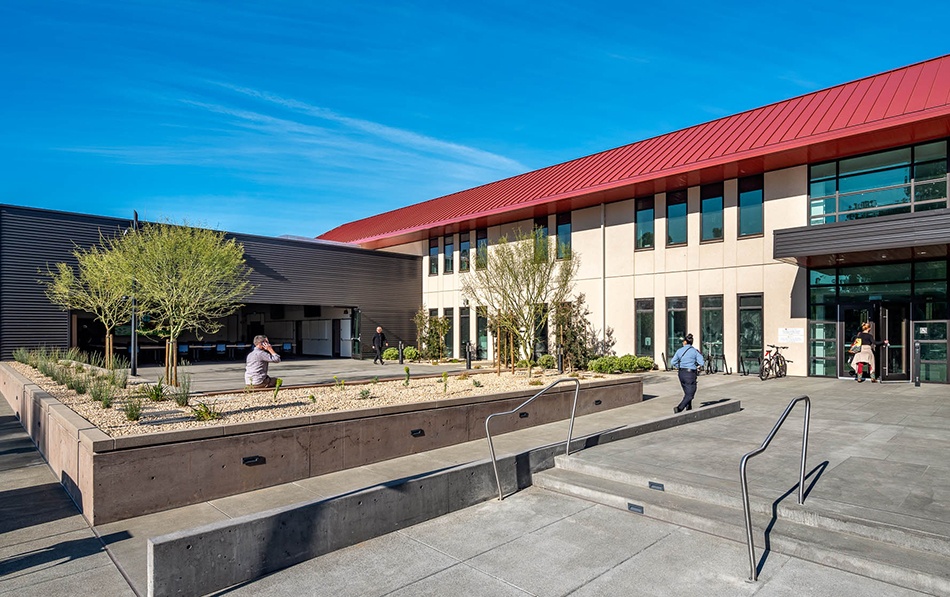
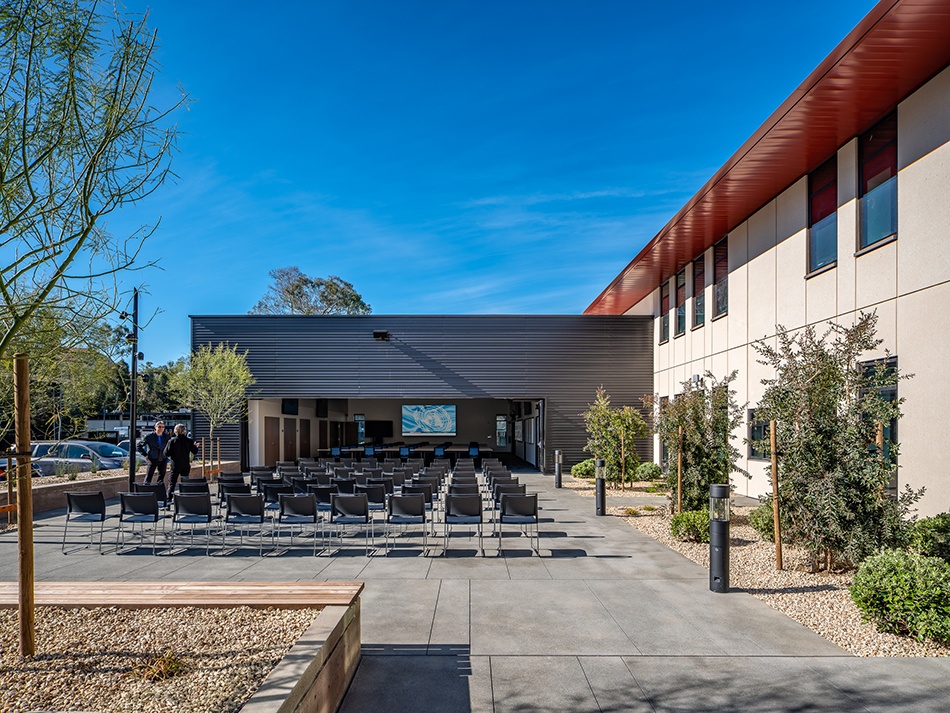
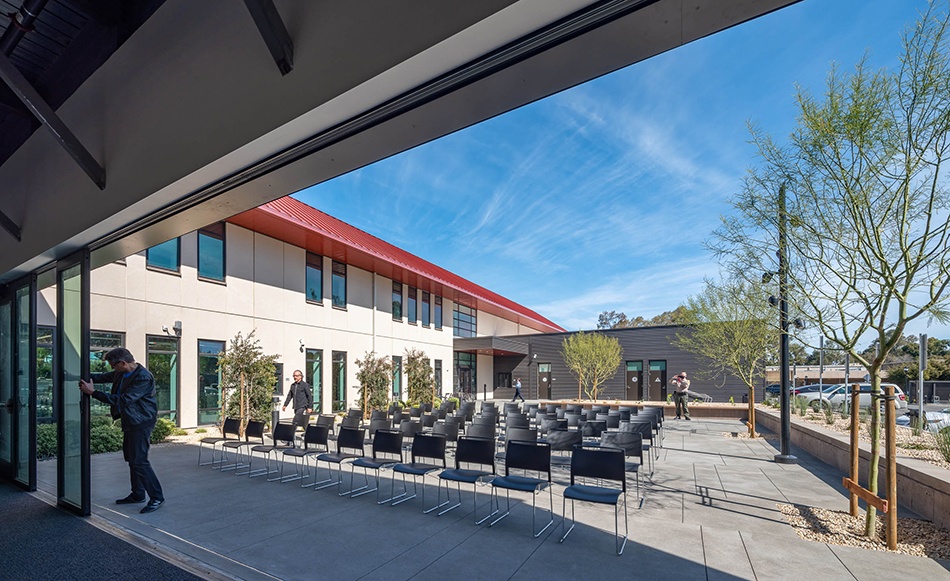
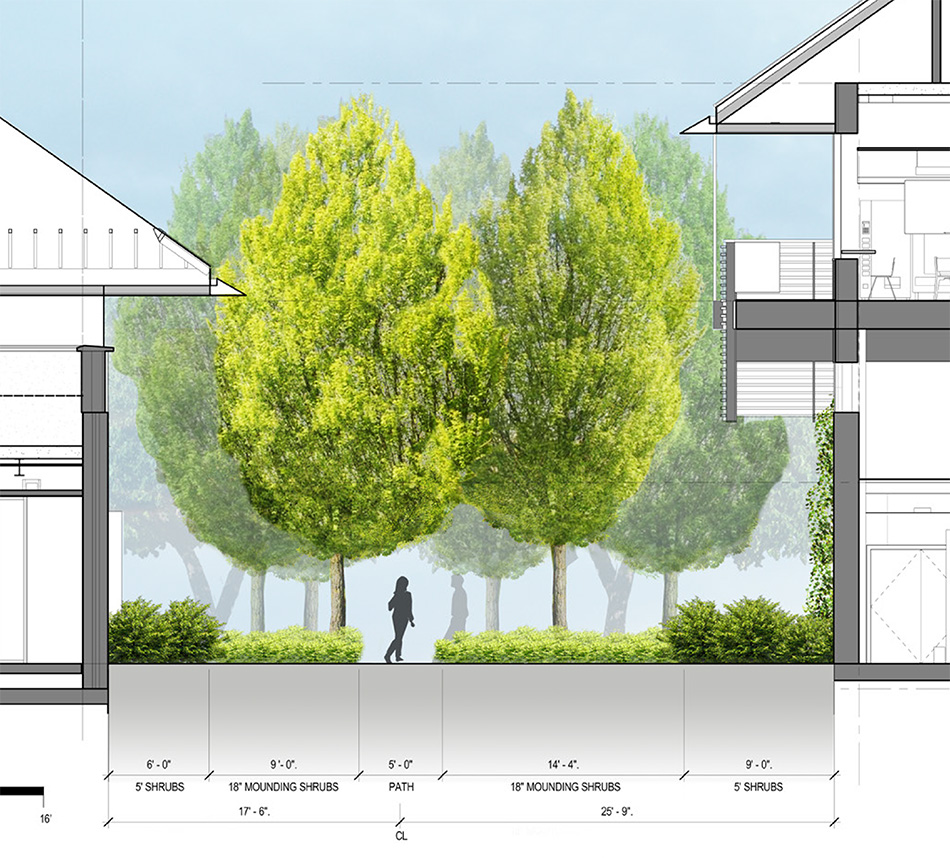
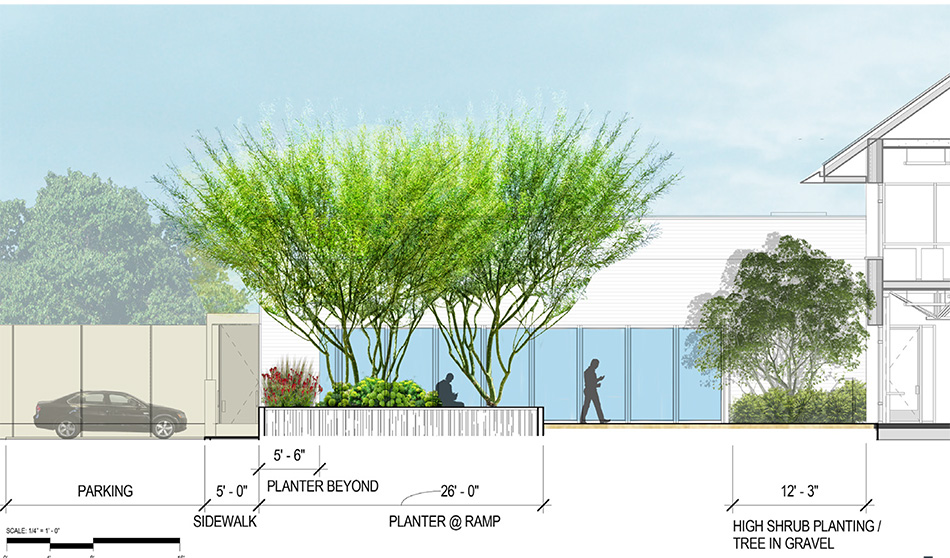
Location: Stanford, California
Owner/Client: Stanford University LBRE / RossDrulisCusenbery ARCHITECTURE
Scope: Site Design & Landscape
Status: Completed 2020
Photography: Kyle Jeffers
Palo Alto Public Safety Building Landscape
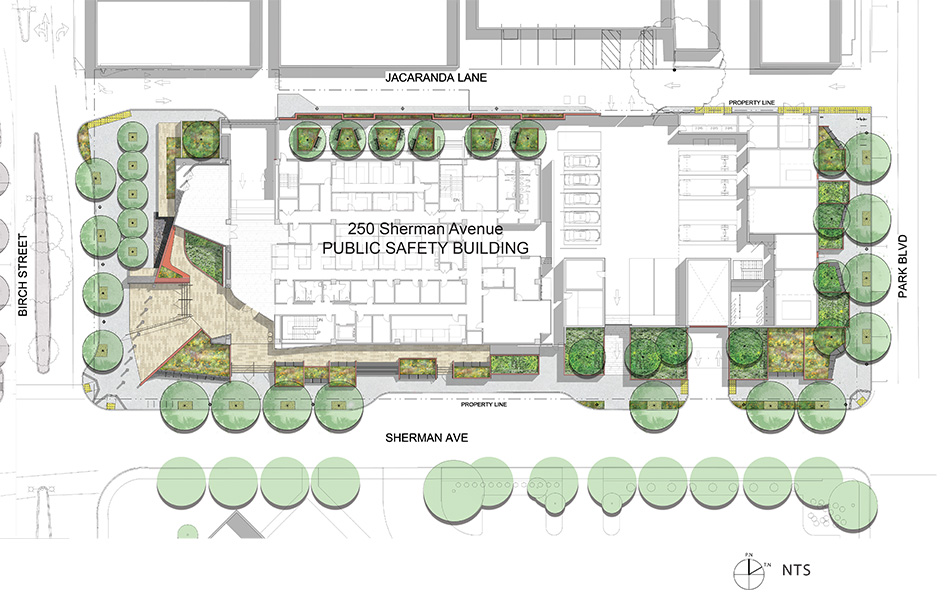
With the Neighborhood in Mind
The Palo Alto Public Safety Building landscape and site design privileges the public pedestrian realm. Each of the four frontages are treated somewhat uniquely, yet they are designed to create a unified streetscape that enhances the pedestrian experience for the California Avenue neighbors and residents. The civic perimeter of the Public Safety Building provides broad walking areas and amenities to the surrounding Palo Alto community members that pass by each day on their way to and from their homes, office, and California Avenue. The new landscape of the site is meant to reinforce the police force’s role in the lively neighborhood as good neighbors and important guardians of the community.
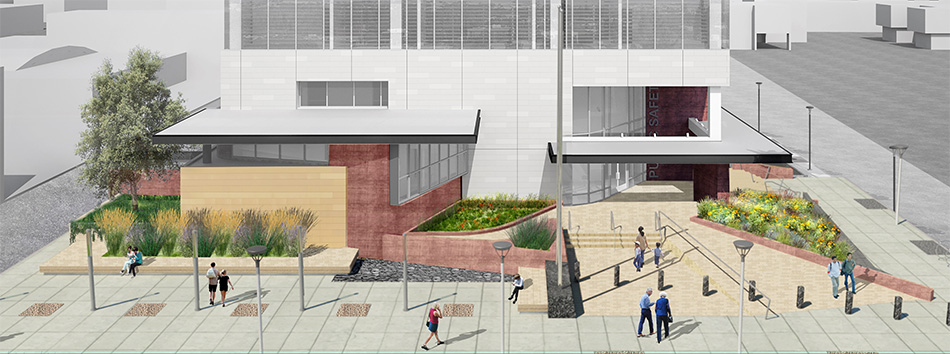
Palette of Plantings
A diverse palette of habitat-producing understory plantings has been developed to include rain gardens, native and adapted grasses, flowering perennials, and courtyard plantings. On Birch Street, the emphasis is on ornamental and native grasses, flowering and ground-covering perennials, and low shrubs. On Sherman Avenue, species include open shrubs such as Western Redbud, native and ornamental grasses, sedges, rushes, and California natives. Opportunities for rain gardens and native plantings occur in several areas throughout the plaza. The plantings at the Park Boulevard frontage will include an alternating rhythm of rain gardens, meadow grasses, and shade-tolerant understory plants. At Jacaranda Lane, trailing shrubs will grace the walls and planters. Diverse street tree plantings line three of the frontages and help us to meet the City of Palo Alto’s urban forestry plan goals through the selection of native species and the use of pavement support systems to provide significant rooting area for successful street trees.
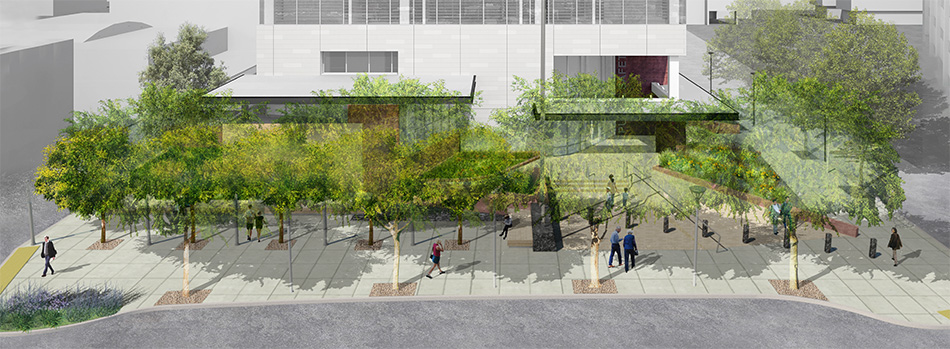
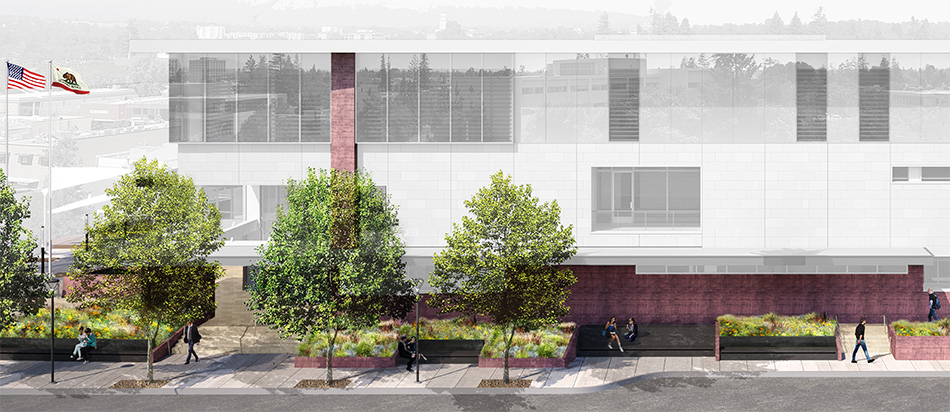
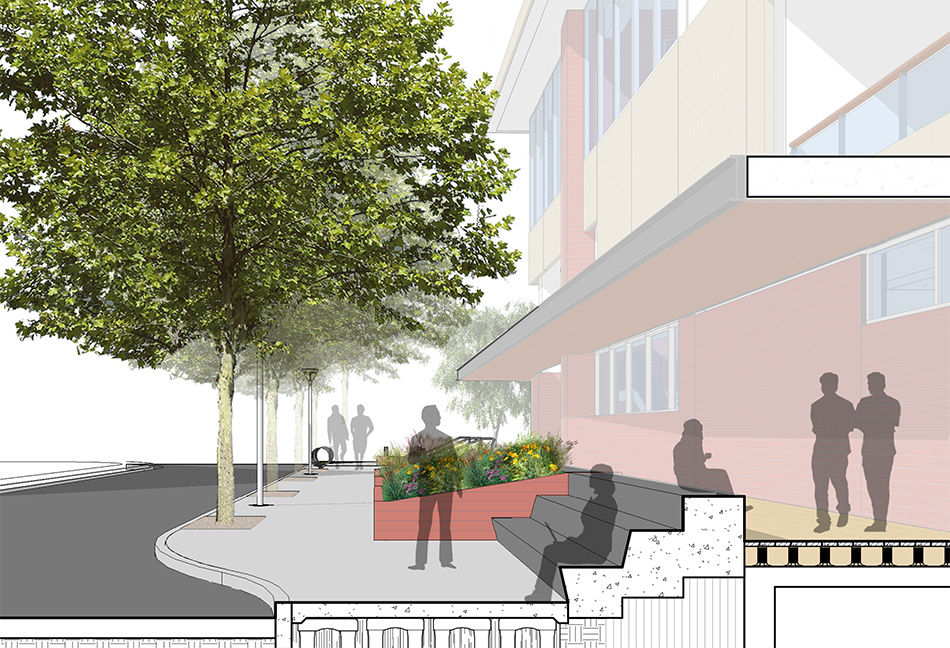
Street by Street
INTERSTICE Architects has made each streetscape on the project a priority for the overall importance and presence of the Public Safety Building to this neighborhood of Palo Alto. The Birch Street frontage is a generous tree-framed sidewalk completed by the streetscape in front of the garage across Birch. The broad stair and welcoming ramp lead from the intersection of Birch Street and Sherman Avenue to the Public Safety Building entry. Seating opportunities are integrated into the plantings that face this wide sidewalk at the Birch Plaza and turn the corner along Sherman Avenue where a row of ginkgo trees define the plaza’s edge, providing shade and seasonality to the entry experience. The streetscape design down Sherman Avenue creates a sheltered building-level paseo and a street-level walkway with a ribbon of rain gardens, raised planters, and seating that invite pedestrians to linger for conversation or meet at lunch time. Along Park Boulevard, the sidewalk is broadened. Raised rain gardens with seating amenities create an active and broad pedestrian zone, and a bike-focused mini-plaza nearest California Avenue is replete with a bicycle repair station and bicycle racks. Meanwhile, a lovely walled courtyard offers staff and employees a space for relaxation outdoors along Jacaranda Lane. This walled garden includes smaller-scape tree plantings of Arbutus and olive trees with bench seating for staff to meet and take breaks in this modest oasis.
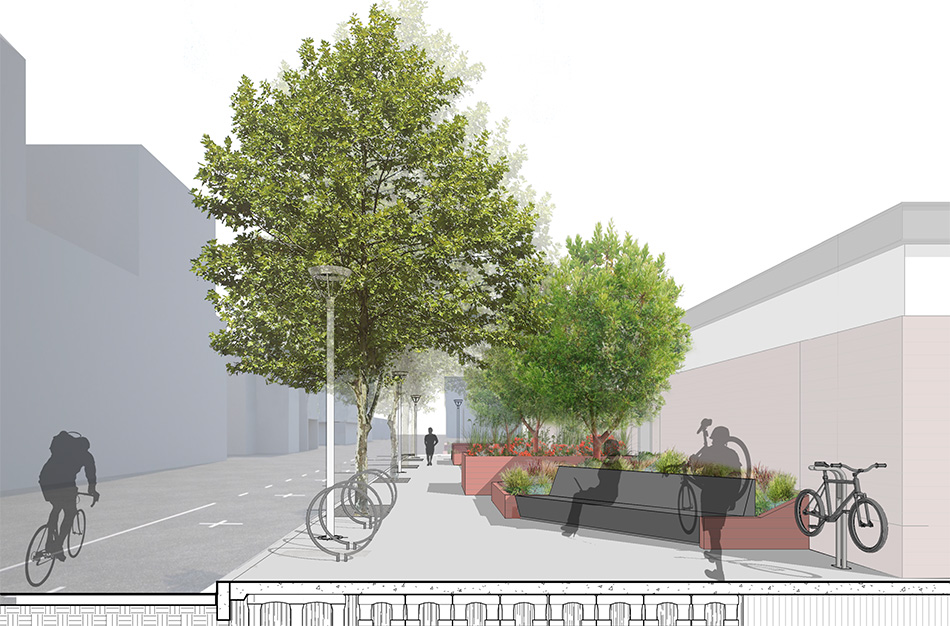
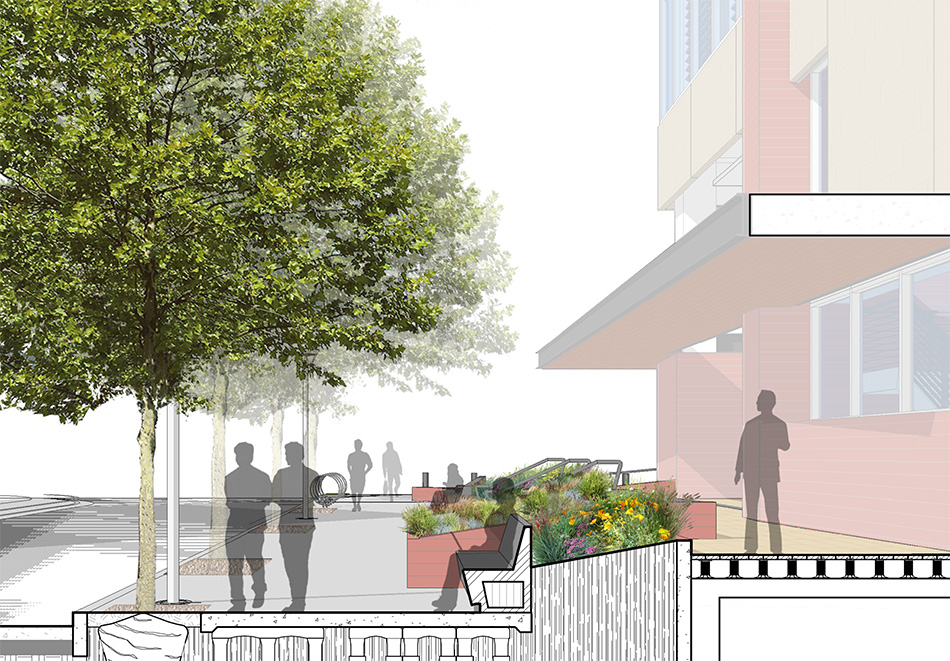
Location: Palo Alto, California
Owner/Client: City of Palo Alto / RossDrulisCusenbery ARCHITECTURE
Scope: Landscape & Streetscape
Status: In Progress
Photography: N/A










